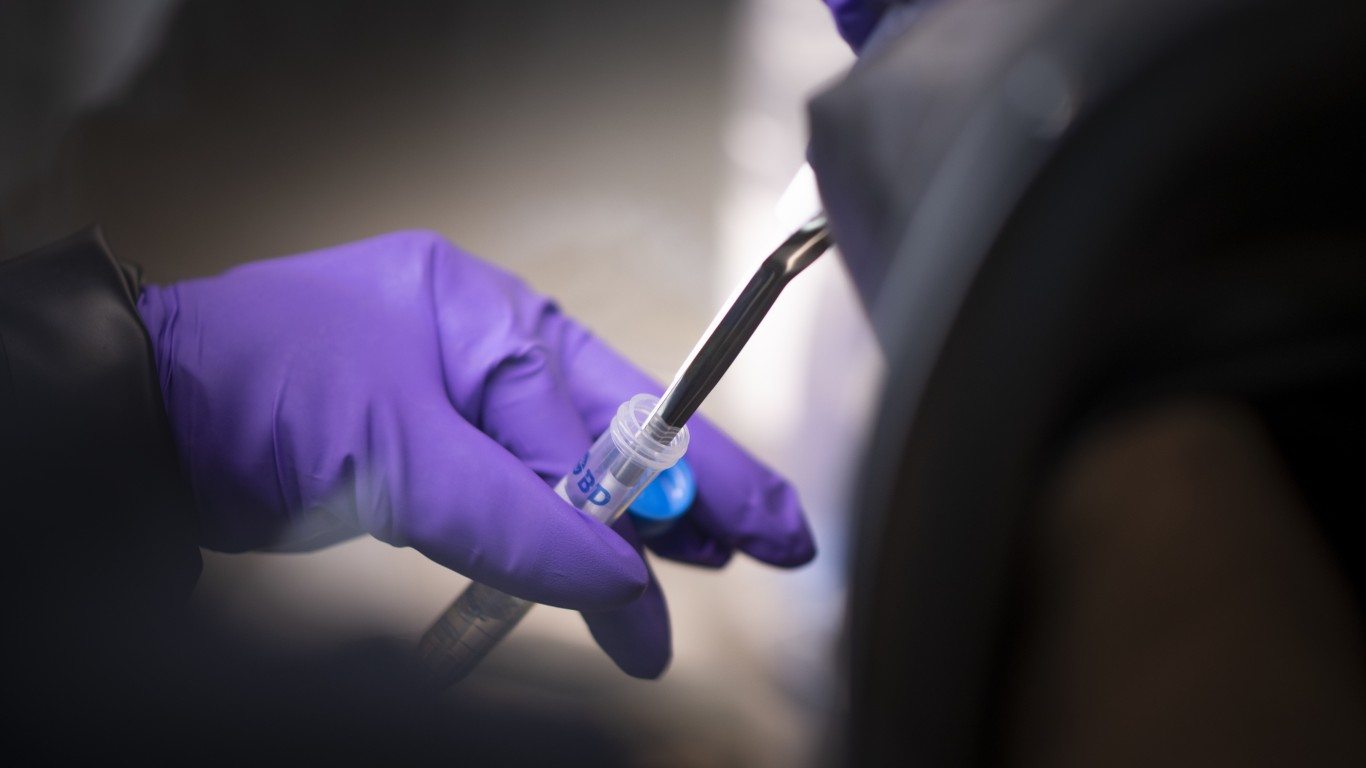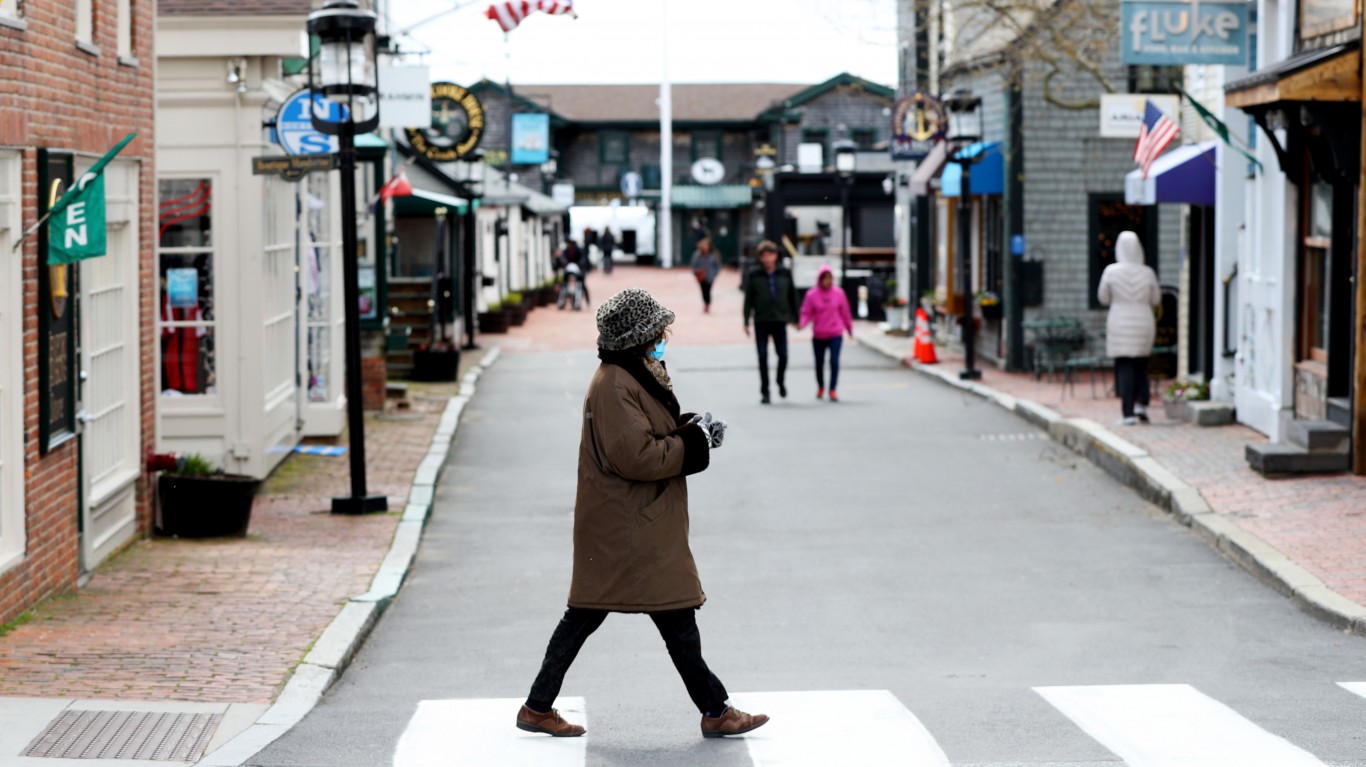
The United States has surpassed more than 2 million confirmed cases of COVID-19, and the death from the coronavirus disease toll has climbed to more than 115,000 as of June 11.
Nationwide, cases have been declining, and states have begun to loosen some or all restrictions. Health experts are concerned that states may be opening too soon. There are already reports of a second wave in certain areas as the number of new COVID-19 cases has recently spiked in some states.
To determine each state’s social distancing measures and rules for reopening, 24/7 Wall St. reviewed executive orders from state governors over the last few weeks.
Even though the number of new COVID-19 cases has plunged in New York — home to the nation’s most densely-populated major city — and in New Jersey — the most densely-populated state — those two states have been slower to reopen their economies.
Other states began pulling back on their restriction orders as early as late April, and seven states never enacted statewide stay-at-home orders at all. COVID-19 daily infection rates have been increasing in some of those states. These are the states where the virus is growing fastest right now.
Click here to see every state’s rules for reopening and social distancing.
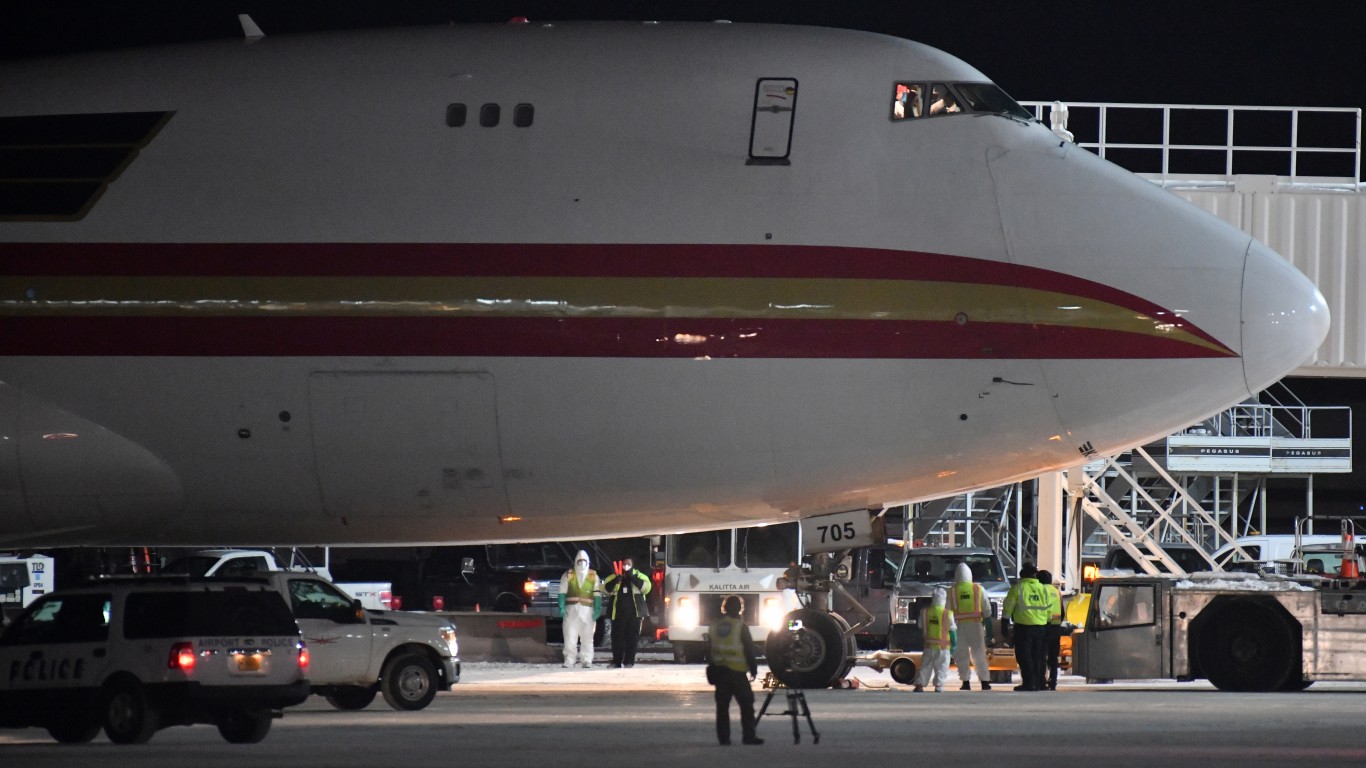
Alaska
> Cumulative COVID-19 cases as of June 11: 80 per 100,000 people — 3rd lowest (total: 593)
> COVID-19-related deaths as of June 11: 1 per 100,000 people — 2nd lowest (total: 11)
> Total tests administered as of June 11: 9,183 per 100,000 people — 8th highest (total: 67,720)
> Date of first confirmed case: 3/12/2020
> Est. peak date as of June 3: 3/18/2020 (est. 88 active infections)
> Population: 737,438
Travelers arriving into Alaska from another state or country now have to follow new protocols: completing a traveler declaration form; presenting results of a negative COVID-19 test taken within the previous 72 hours; or taking a test upon arrival and self-quarantining until results are known. Travelers can only use road or maritime highways, and travel to remote areas is restricted to essential travel. Alaska is in phase 3 of reopening. All businesses, religious gatherings, libraries, museums, recreational activities, and sport activities can open.
[in-text-ad]
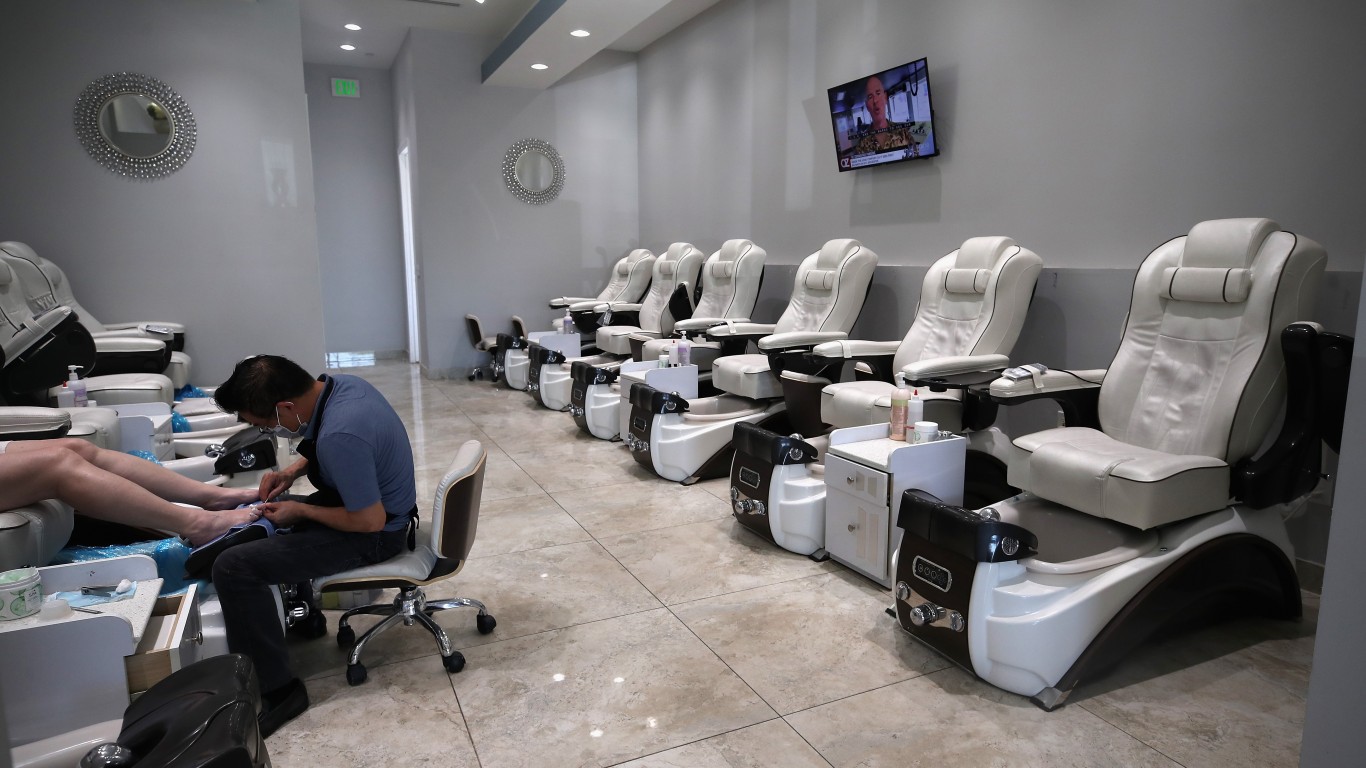
Arizona
> Cumulative COVID-19 cases as of June 11: 416 per 100,000 people — 23rd highest (total: 29,852)
> COVID-19-related deaths as of June 11: 15 per 100,000 people — 24th highest (total: 1,095)
> Total tests administered as of June 11: 4,179 per 100,000 people — 13th lowest (total: 299,687)
> Date of first confirmed case: 1/26/2020
> Est. peak date as of June 3: 4/16/2020 (est. 2,386 active infections)
> Population: 7,171,646
The Arizona Department of Education on June 1 released reopening guidance for schools for the 2020-2021 school year. Schools will resume in-person instruction and should operate on intermittent schedules. Students should be checked for temperatures and may be required to wear masks. Schools should consider reducing class sizes.
Retail stores have opened. So have gyms, spas, movie theaters, and community swimming pools. Restaurants have resumed dine-in services. People are strongly encouraged to continue practicing social distancing. No specific date was given for the start of the next phase of the state’s reopening.
Arkansas
> Cumulative COVID-19 cases as of June 11: 344 per 100,000 people — 19th lowest (total: 10,368)
> COVID-19-related deaths as of June 11: 5 per 100,000 people — 9th lowest (total: 165)
> Total tests administered as of June 11: 5,847 per 100,000 people — 24th lowest (total: 176,217)
> Date of first confirmed case: 3/11/2020
> Est. peak date as of June 3: 4/14/2020 (est. 317 active infections)
> Population: 3,013,825
Arkansas was one of a handful of states to never issue a statewide stay-at-home order, but nonessential businesses were closed for a period. Establishments like gyms and barbershops began reopening in early May. Since May 11, restaurants have resumed dine-in services but with limitations — they can only seat a third of their total capacity. High school and community sports teams were allowed to resume practice events starting June 1, under strict measures. Gov. Asa Hutchinson postponed in-person graduation ceremonies until at least July 1.
Short-term rentals such as hotels, motels, and vacation rentals are limited to “authorized guests,” which include national guard members, first responders, homeless people, and journalists. Visitors coming from other countries or Connecticut, New Jersey, New Orleans, or New York are required to self-quarantine for 14 days.
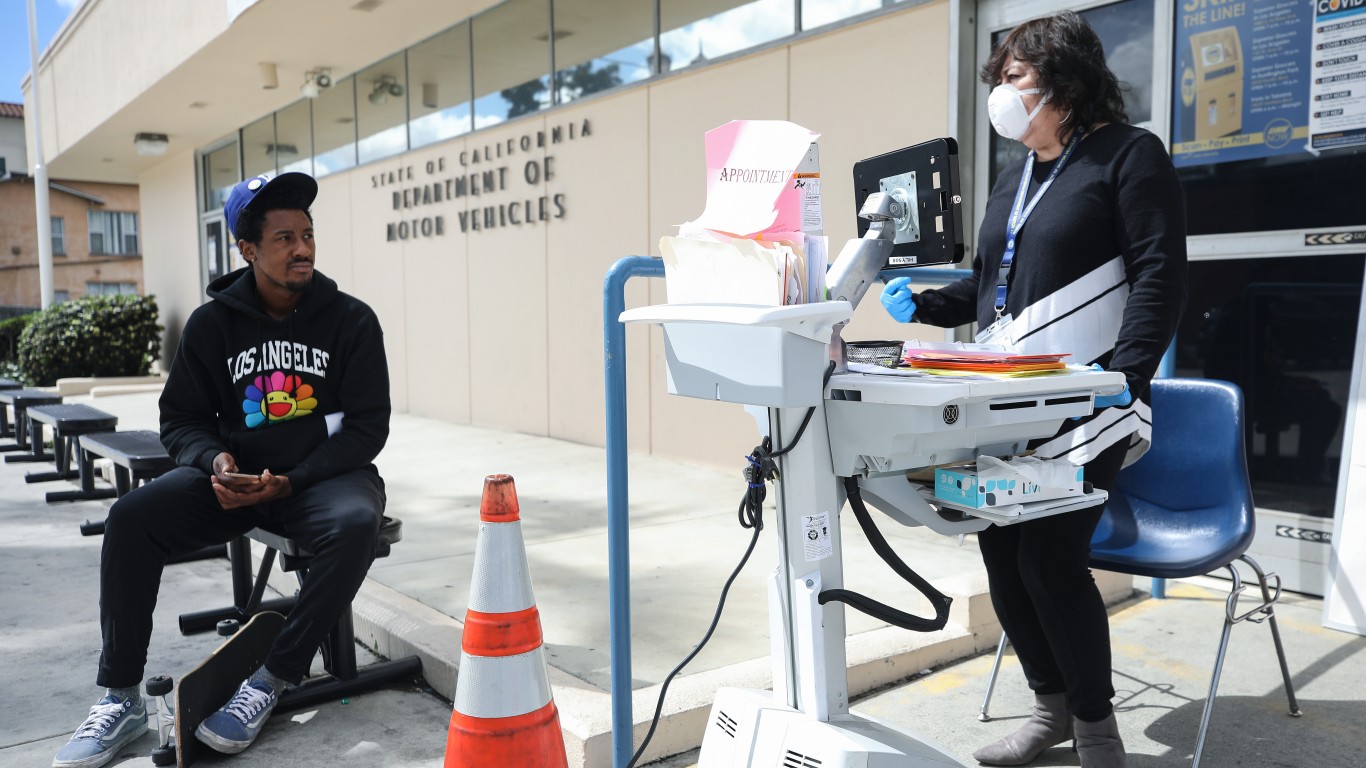
California
> Cumulative COVID-19 cases as of June 11: 344 per 100,000 people — 20th lowest (total: 136,191)
> COVID-19-related deaths as of June 11: 12 per 100,000 people — 23rd lowest (total: 4,776)
> Total tests administered as of June 11: 6,423 per 100,000 people — 22nd highest (total: 2,540,798)
> Date of first confirmed case: 1/25/2020
> Est. peak date as of June 3: 4/8/2020 (est. 10,236 active infections)
> Population: 39,557,045
A stay-at-home order, which has no set end date, is still in effect, though some restrictions have already been lifted. The state is reopening at the county level, with counties that meet specific criteria allowed to lift certain restrictions. An increase in COVID-19 cases in early June may delay reopening in certain counties.
California is currently in phase 2 of its four-phase reopening, which started on May 8. This phase allows lower-risk businesses to reopen. In the later stage of phase 2, retail, museums, and dine-in eateries will be allowed to reopen with social distancing protocols. After June 12, music, TV and film production, as well as professional sports ( without fans) will be able to resume operations subject to approval by county public health officials.
[in-text-ad-2]
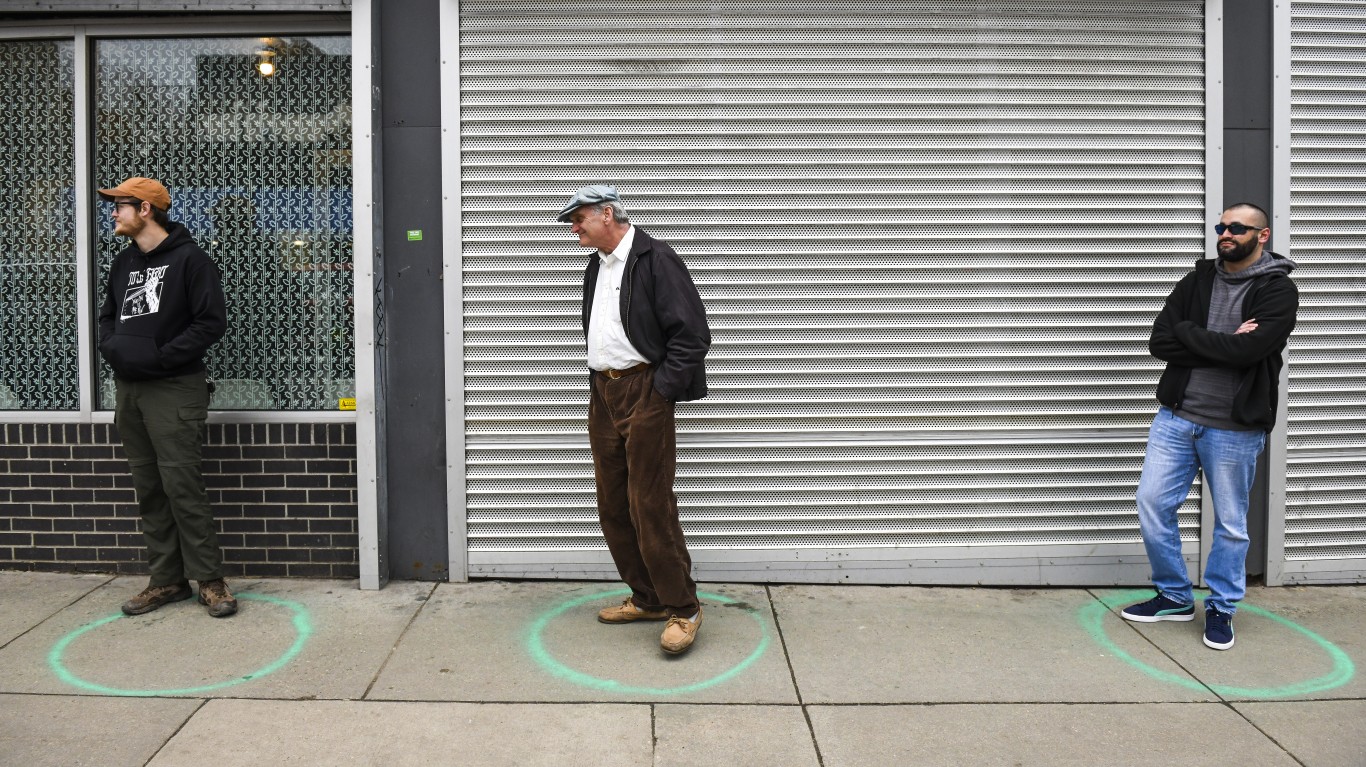
Colorado
> Cumulative COVID-19 cases as of June 11: 500 per 100,000 people — 20th highest (total: 28,499)
> COVID-19-related deaths as of June 11: 28 per 100,000 people — 14th highest (total: 1,573)
> Total tests administered as of June 11: 3,999 per 100,000 people — 10th lowest (total: 227,761)
> Date of first confirmed case: 3/5/2020
> Est. peak date as of June 3: 4/2/2020 (est. 3,909 active infections)
> Population: 5,695,564
Gov. Jared Polis signed an order on June 1 shifting Colorado to a Safer at Home and in the Vast, Great Outdoors order from the previous Safer at Home order. The new order now encourages people to go outside while maintaining social distancing. It also extends Safer at Home requirements like limiting public gatherings to no more than 10 people for another 30 days. People are asked to wear masks and stay 6 feet apart. Playgrounds and swimming pools are allowed to open at limited capacity. Public and private gatherings are limited to 10 people. Nonessential employees are strongly encouraged to keep working from home for at least until the end of June.
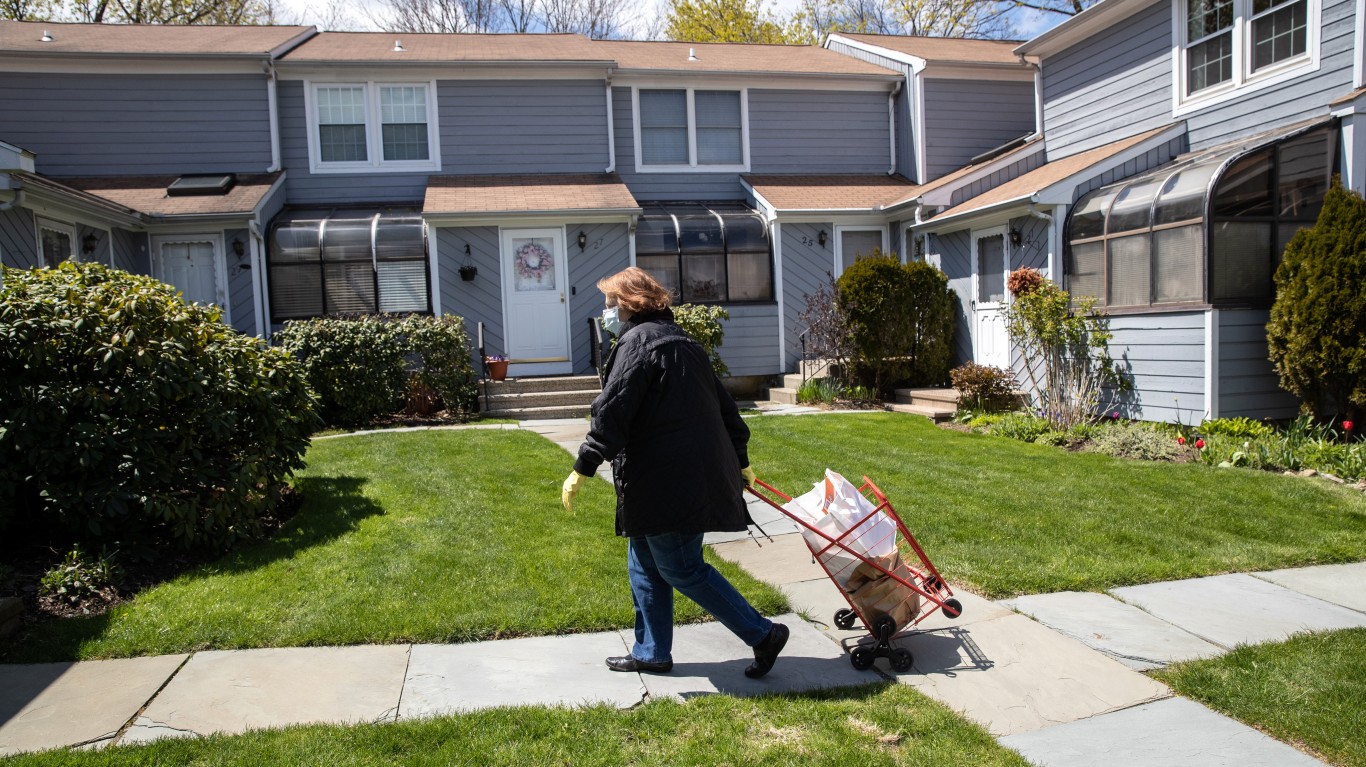
Connecticut
> Cumulative COVID-19 cases as of June 11: 1,241 per 100,000 people — 5th highest (total: 44,347)
> COVID-19-related deaths as of June 11: 115 per 100,000 people — 3rd highest (total: 4,120)
> Total tests administered as of June 11: 8,817 per 100,000 people — 9th highest (total: 315,014)
> Date of first confirmed case: 3/8/2020
> Est. peak date as of June 3: 4/5/2020 (est. 10,932 active infections)
> Population: 3,572,665
Connecticut announced that summer camps will be allowed to open on June 29, in compliance with state requirements. As of June 1, barbershops, hair salons, and tribal casinos were allowed to reopen. Gov. Ned Lamont’s order on limits on social gatherings was amended, and as of June 1, outdoor gatherings of up to 25 people were allowed, in compliance with social distancing protocols of 6 feet apart and wearing of masks. As of June 2, child care facilities have been allowed to have 50 kids, up from 30. Outdoor and in-person graduation ceremonies can be held after July 6.
[in-text-ad]

Delaware
> Cumulative COVID-19 cases as of June 11: 1,040 per 100,000 people — 6th highest (total: 10,056)
> COVID-19-related deaths as of June 11: 43 per 100,000 people — 11th highest (total: 413)
> Total tests administered as of June 11: N/A
> Date of first confirmed case: 3/11/2020
> Est. peak date as of June 3: 4/17/2020 (est. 978 active infections)
> Population: 967,171
Delaware’s state museums reopened on June 1 for self-guided tours. Personal care services such as massage therapy were allowed to reopen at 30% capacity on June 8. Delaware will begin phase 2 of reopening on June 15, with retailers, restaurants, and other establishments allowed to expand to 60% capacity from 30% during phase 1.
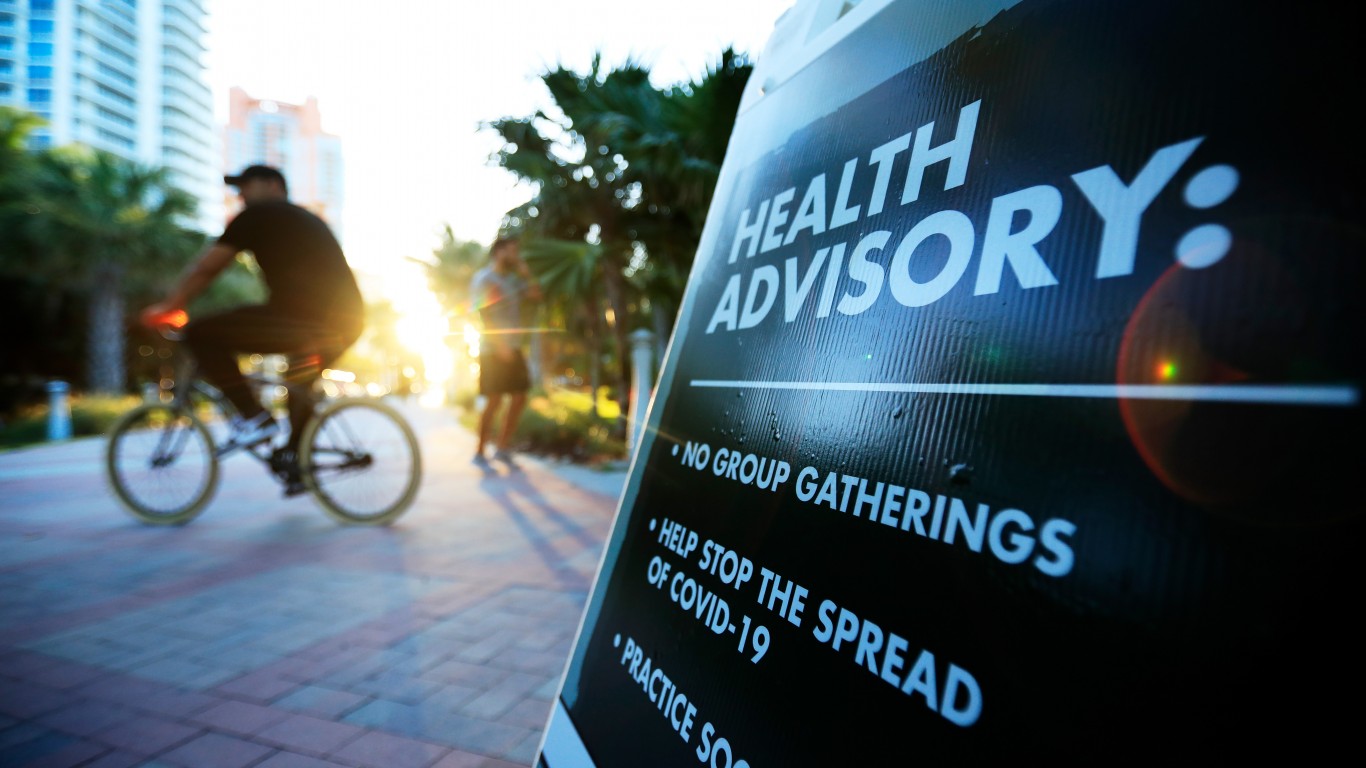
Florida
> Cumulative COVID-19 cases as of June 11: 324 per 100,000 people — 15th lowest (total: 69,069)
> COVID-19-related deaths as of June 11: 13 per 100,000 people — 24th lowest (total: 2,848)
> Total tests administered as of June 11: 6,140 per 100,000 people — 25th highest (total: 1,307,728)
> Date of first confirmed case: 3/1/2020
> Est. peak date as of June 3: 4/1/2020 (est. 4,674 active infections)
> Population: 21,299,325
Gov. Ron DeSantis announced phase 2 of the reopening of Florida’s economy on June 3. Under phase 2, bars and pubs may operate at 50% capacity inside and full capacity outside for dine-in service. Movie theaters and entertainment venues can operate at 50% capacity also. There are restrictions on salons and barbershops. All Florida counties, except Miami-Dade, Broward, and Palm Beach, entered phase 2 on June 5.
The easing of restrictions comes as the number of new COVID-19 cases in Florida has been rising. The state Department of Health reported an increase in new cases since June 1. Residents are advised not to gather in groups of more than 50 people. Elderly people and those with preexisting conditions are encouraged to avoid crowds of any size.
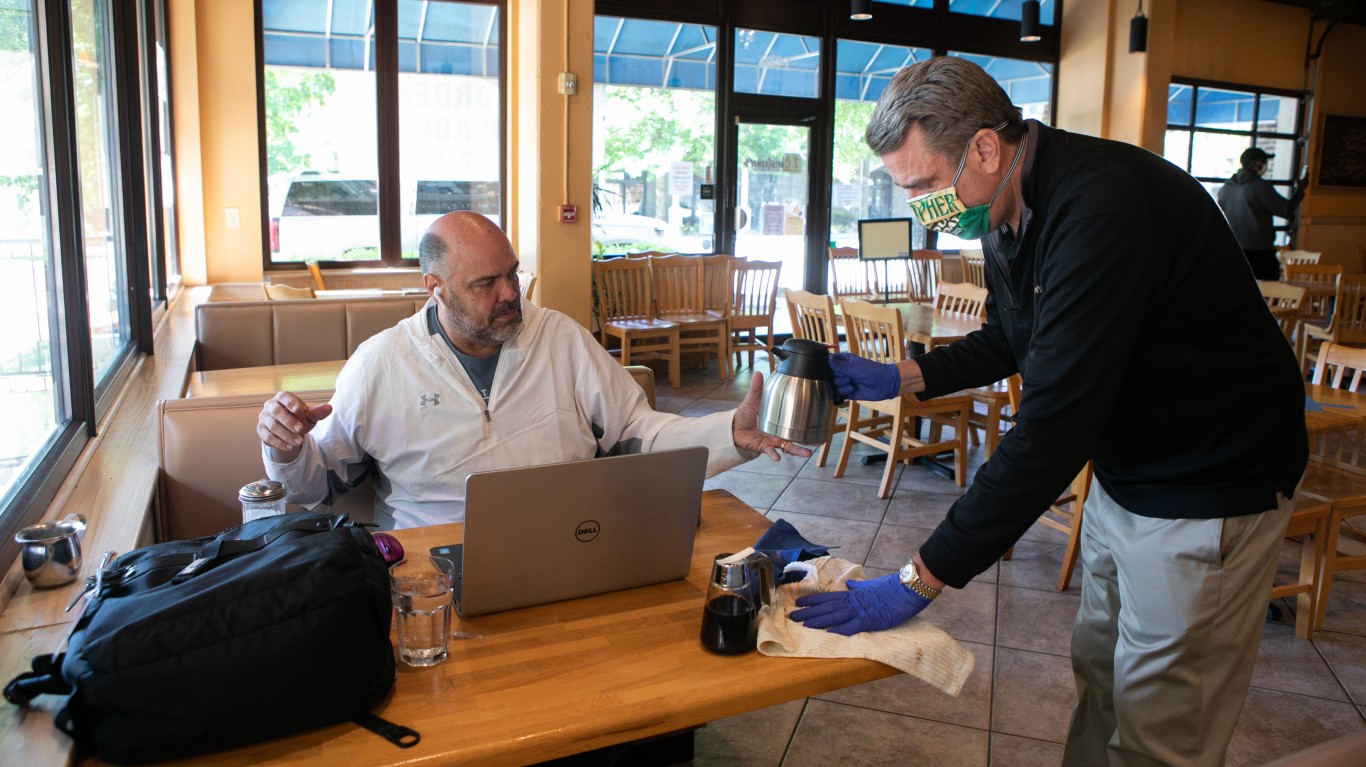
Georgia
> Cumulative COVID-19 cases as of June 11: 515 per 100,000 people — 18th highest (total: 54,155)
> COVID-19-related deaths as of June 11: 22 per 100,000 people — 15th highest (total: 2,350)
> Total tests administered as of June 11: 6,375 per 100,000 people — 24th highest (total: 670,575)
> Date of first confirmed case: 3/2/2020
> Est. peak date as of June 3: 4/1/2020 (est. 5,222 active infections)
> Population: 10,519,475
The general shelter-in-place order expired on April 30, and the shelter-in-place order for older state residents and other at-risk individuals is set to expire on June 12. Additionally, all Georgians are encouraged to remain home whenever possible and to maintain a distance of at least 6 feet in public. Gatherings of 25 people or more were allowed in Georgia as of June, provided social distancing is maintained. Gov. Brian Kemp permitted amusement park rides, carnivals, circuses, and water parks to open beginning June 12 in compliance with health requirements.
[in-text-ad-2]
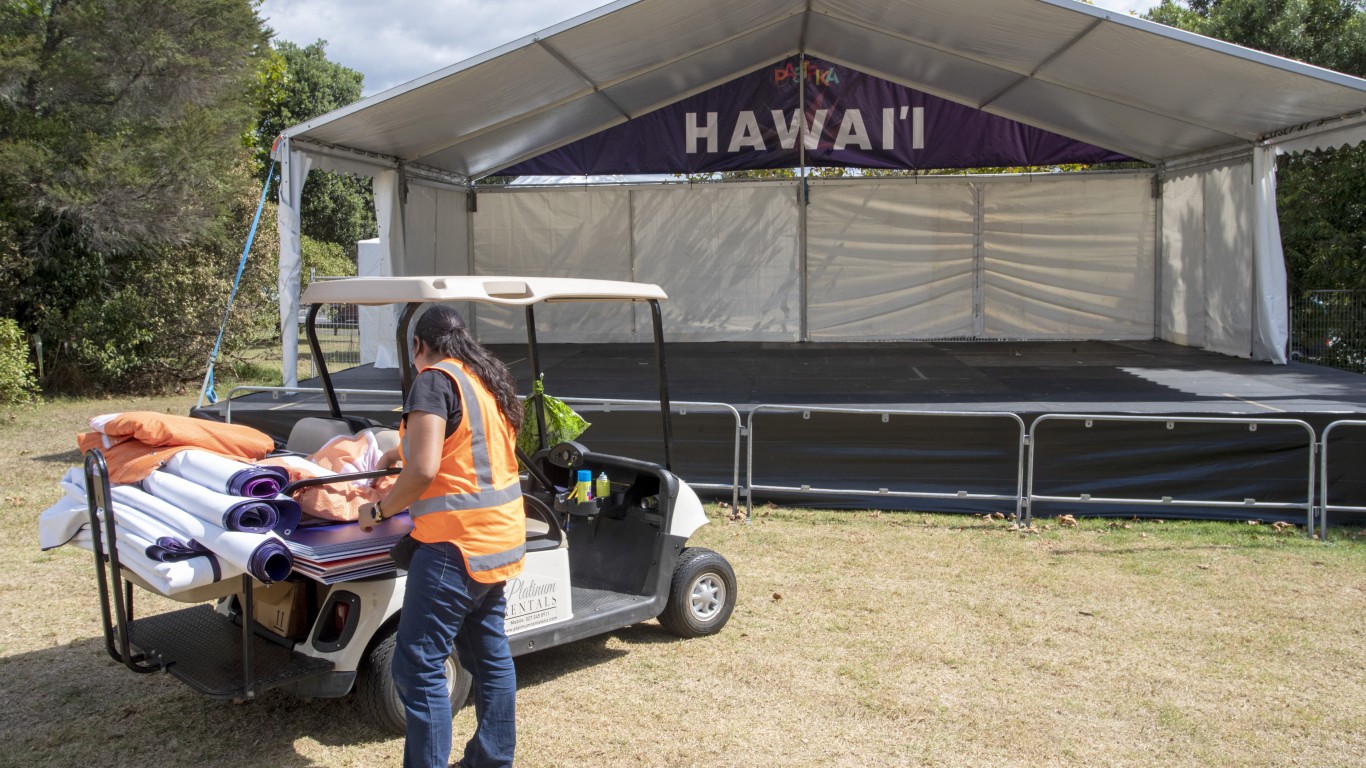
Hawaii
> Cumulative COVID-19 cases as of June 11: 48 per 100,000 people — the lowest (total: 682)
> COVID-19-related deaths as of June 11: 1 per 100,000 people — the lowest (total: 17)
> Total tests administered as of June 11: 4,541 per 100,000 people — 14th lowest (total: 64,501)
> Date of first confirmed case: 3/6/2020
> Est. peak date as of June 3: 3/27/2020 (est. 76 active infections)
> Population: 1,420,491
The state is set to lift the 14-day quarantine requirement for those traveling between islands on June 16, but it is requiring thermal screening at the airport. Travelers may be prevented from flying if they have a temperature above 100.4 degrees Fahrenheit.
Beaches are open for recreational activities and as long as social distance is maintained. Malls, car washes, nonemergency medical visits, and retailers were allowed to reopen. The state is in phase 2 of reopening, allowing indoor gathering places and exercise facilities, as well as museums, theaters, personal services, and dine-in restaurants to reopen. Boaters can allow up to 10 people per boat (unless all people aboard are from the same household). Surf schools and kayak rentals can operate with a 10-person limit.

Idaho
> Cumulative COVID-19 cases as of June 11: 186 per 100,000 people — 8th lowest (total: 3,260)
> COVID-19-related deaths as of June 11: 5 per 100,000 people — 8th lowest (total: 85)
> Total tests administered as of June 11: 3,409 per 100,000 people — 8th lowest (total: 59,802)
> Date of first confirmed case: 3/13/2020
> Est. peak date as of June 3: 3/27/2020 (est. 311 active infections)
> Population: 1,754,208
Idaho entered phase 3 of its four-phase reopening plan on May 30, and that is scheduled to end on June 12. Phase 4 is expected to start on June 13 provided there is no significant increase in cases. Gatherings of more than 50 people will be allowed where social distancing can be practiced. Nonessential travel is permitted to locations without ongoing transmission of the virus. Bars and movie theaters can reopen if they meet safety protocols, and nightclubs and large venues can open with limited standing-room capacity. Employees can return to offices if they practice social distancing.
The state still encourages face mask use and maintaining 6 feet of distance from others in public.
[in-text-ad]

Illinois
> Cumulative COVID-19 cases as of June 11: 1,019 per 100,000 people — 7th highest (total: 129,837)
> COVID-19-related deaths as of June 11: 48 per 100,000 people — 8th highest (total: 6,095)
> Total tests administered as of June 11: 8,634 per 100,000 people — 10th highest (total: 1,100,002)
> Date of first confirmed case: 1/24/2020
> Est. peak date as of June 3: 4/25/2020 (est. 13,243 active infections)
> Population: 12,741,080
Restaurants began to reopen in Chicago on June 3 for outside dining only. Retail shops, salons, and barbershops were permitted to open as well, though subject to reduced capacity, and workers and customers must wear face coverings over their nose and mouth.
People must wear masks or face coverings in public places where they cannot maintain 6 feet of distance from others. Public and private schools in the state can reopen for limited in-person summer school. No more than 10 people can be present in an enclosed area, and they must be 6 feet apart. Bars and restaurants can start selling cocktails for pickup and delivery. Phase 4 of reopening is set to begin on June 26 but only in counties that meet certain criteria.
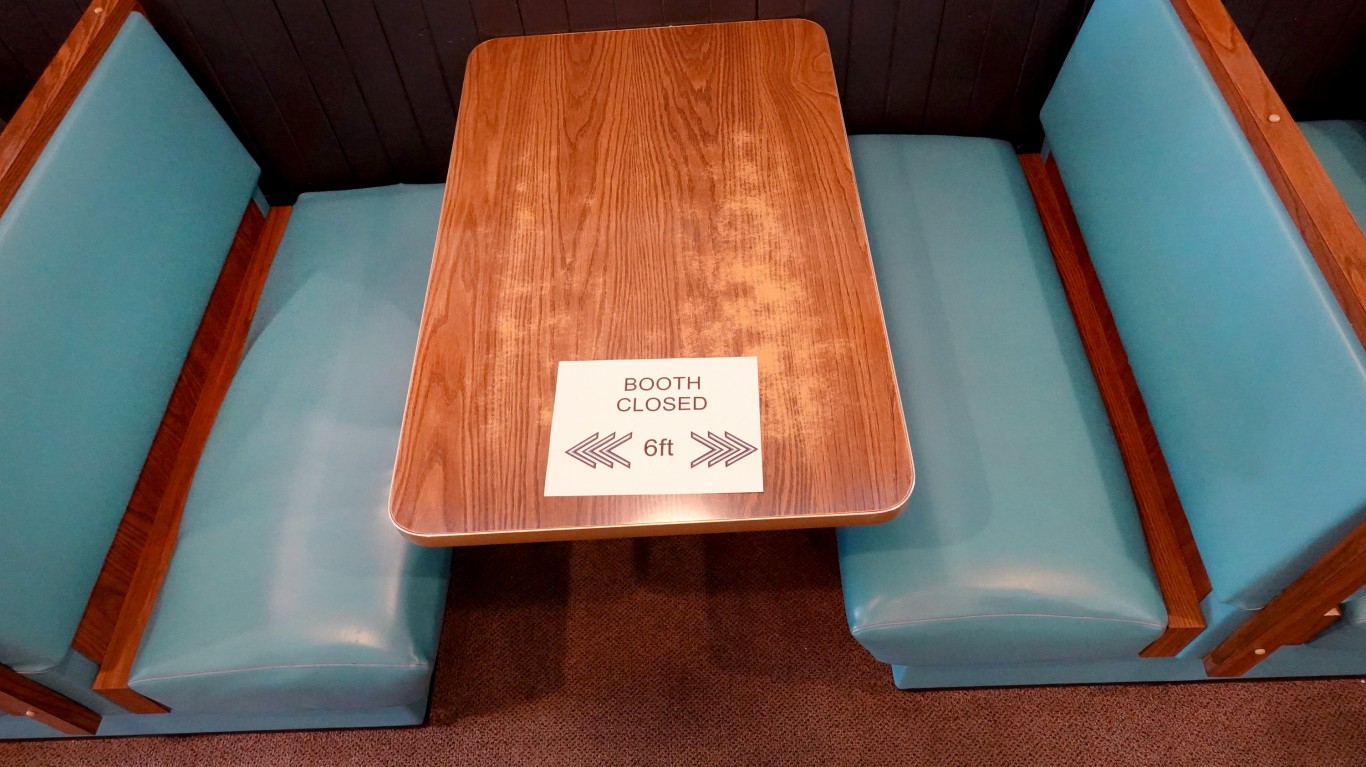
Indiana
> Cumulative COVID-19 cases as of June 11: 573 per 100,000 people — 17th highest (total: 38,337)
> COVID-19-related deaths as of June 11: 32 per 100,000 people — 12th highest (total: 2,173)
> Total tests administered as of June 11: 4,783 per 100,000 people — 16th lowest (total: 320,094)
> Date of first confirmed case: 3/6/2020
> Est. peak date as of June 3: 4/5/2020 (est. 4,933 active infections)
> Population: 6,691,878
Much of Indiana moved to phase 3 beginning May 22, and phase 4 is expected to begin on June 12. Access restrictions to state government building will be lifted. Professional office building employees will be able to resume work at full capacity. Retail stores and malls can open at full capacity. Restaurants can expand indoor dining to 75% capacity. Bars, nightclubs, bar seating in restaurants, movie theaters, bowling alleys, and similar entertainment facilities can open at 50% capacity with social distancing rules in place. Recreational sports can resume with restrictions. Amusement and water parks can open at 50% capacity with restrictions.

Iowa
> Cumulative COVID-19 cases as of June 11: 713 per 100,000 people — 11th highest (total: 22,516)
> COVID-19-related deaths as of June 11: 20 per 100,000 people — 19th highest (total: 629)
> Total tests administered as of June 11: 6,420 per 100,000 people — 23rd highest (total: 202,612)
> Date of first confirmed case: 3/8/2020
> Est. peak date as of June 3: 5/8/2020 (est. 1,637 active infections)
> Population: 3,156,145
Iowa’s speedways, racetracks, and amphitheaters were allowed to reopen on June 1. Casinos were also allowed to reopen, as well as amusement parks, bowling alleys, pool halls, and arcades. These venues were allowed to reopen at 50% capacity and maintain social distancing requirements. Employees at the casinos are required to wear masks and be stationed behind Plexiglas. Hand sanitizers are to be located throughout the casinos. Gambling venues must restrict the number of patrons on the gaming floor and waging area to 50% of capacity and maintain social distancing measures of 6 feet. Bars and other establishments that serve alcohol can reopen for indoor and outdoor seating at 50% capacity.
[in-text-ad-2]
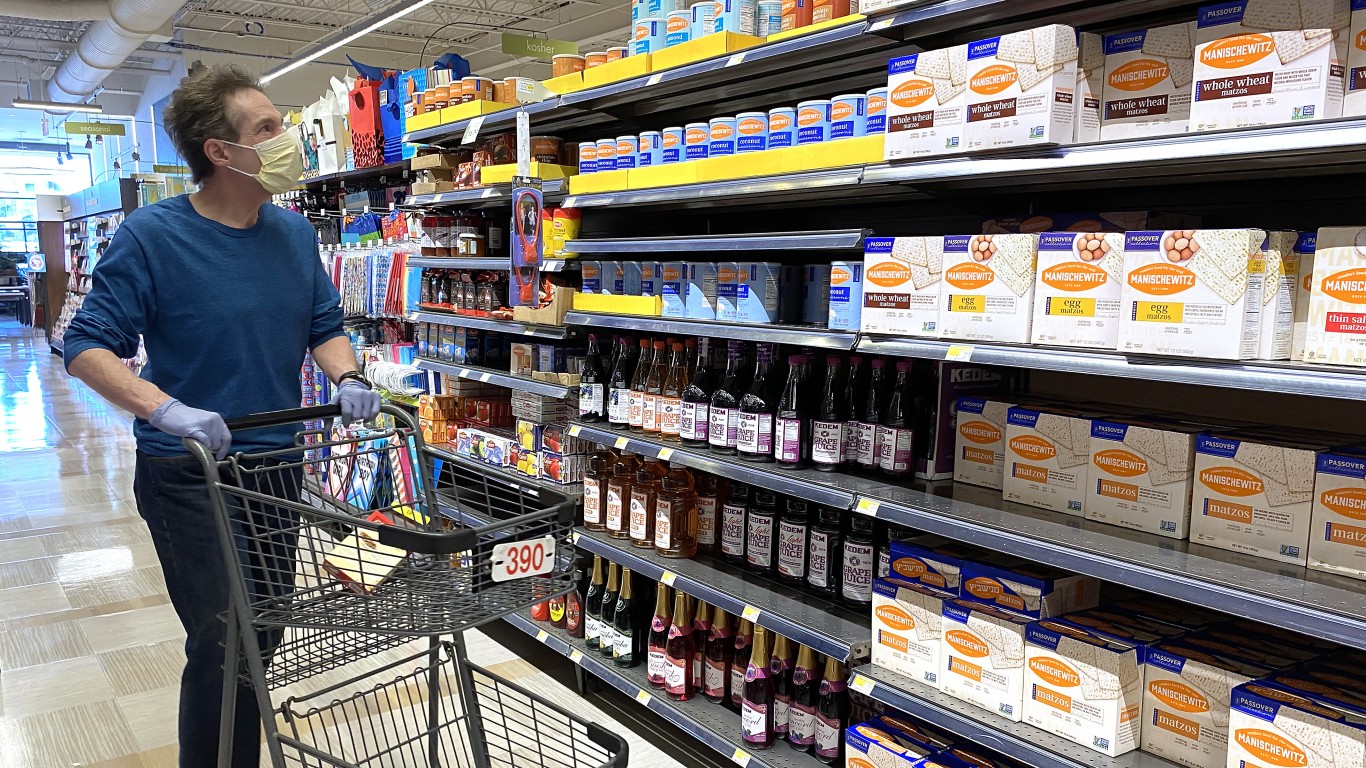
Kansas
> Cumulative COVID-19 cases as of June 11: 366 per 100,000 people — 21st lowest (total: 10,650)
> COVID-19-related deaths as of June 11: 8 per 100,000 people — 14th lowest (total: 236)
> Total tests administered as of June 11: 00 per 100,000 people — 7th lowest (total: 00)
> Date of first confirmed case: 3/7/2020
> Est. peak date as of June 3: 3/26/2020 (est. 696 active infections)
> Population: 2,911,510
The third phase of the reopening began June 8. Social gatherings of up to 45 people are now allowed, up from 15. Bars and restaurants must preserve a 6-foot distance between tables, booths, and barstools. Casinos and indoor leisure spaces can open as well. Nonessential travel may resume. Restrictions on on-site staffing have been lifted. All education, activities, venues and establishments can operate if they follow public health guidelines. Local governments can impose stricter rules.
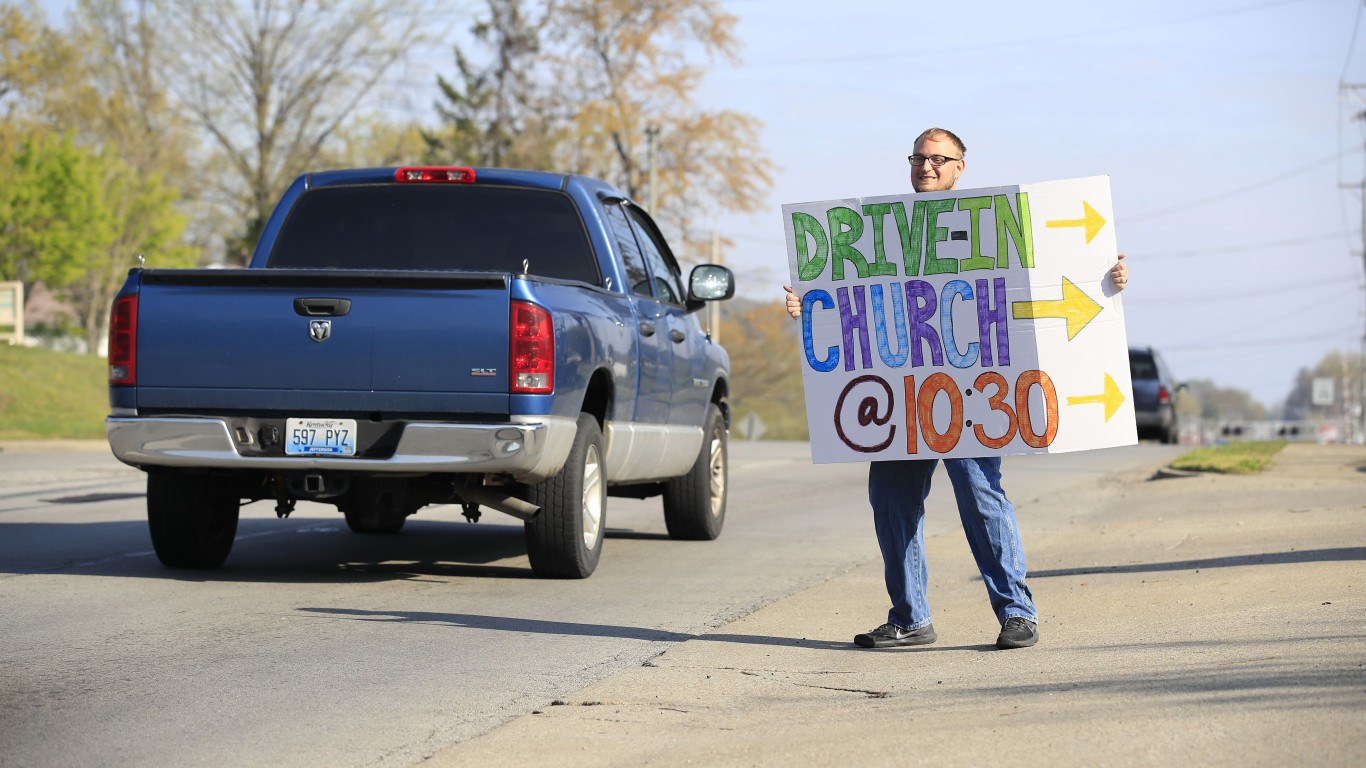
Kentucky
> Cumulative COVID-19 cases as of June 11: 266 per 100,000 people — 12th lowest (total: 11,883)
> COVID-19-related deaths as of June 11: 11 per 100,000 people — 20th lowest (total: 484)
> Total tests administered as of June 11: 6,134 per 100,000 people — 25th lowest (total: 274,107)
> Date of first confirmed case: 3/6/2020
> Est. peak date as of June 3: 3/27/2020 (est. 1,324 active infections)
> Population: 4,468,402
Movie theaters and fitness centers were allowed to reopen on June 1, and museums, outdoor attractions, aquariums, libraries, and distilleries were allowed to reopen on June 8. Campgrounds can reopen on June 11, and child care services can reopen with reduced capacity on June 15. Venues such as bars that hold 50 or fewer people and gatherings of up to 50 people can reopen starting June 29, depending on whether they meet safety criteria. Businesses that were permitted to operate at 33% capacity beginning May 22 will be allowed to increase capacity to 50% on June 22, provided they comply with guidelines. NASCAR races will return to the Kentucky Speedway with no live audience beginning July 9.
[in-text-ad]
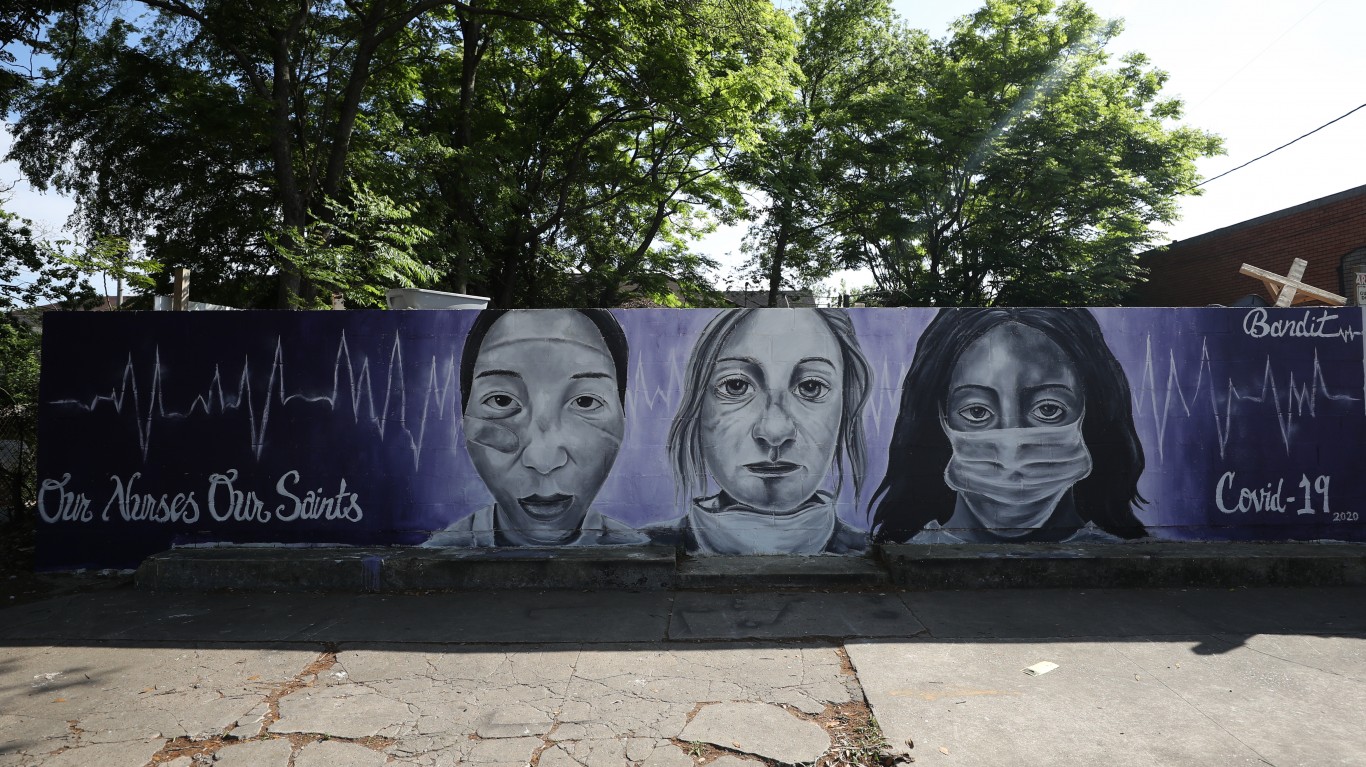
Louisiana
> Cumulative COVID-19 cases as of June 11: 945 per 100,000 people — 9th highest (total: 44,030)
> COVID-19-related deaths as of June 11: 61 per 100,000 people — 6th highest (total: 2,855)
> Total tests administered as of June 11: 9,874 per 100,000 people — 6th highest (total: 460,120)
> Date of first confirmed case: 3/9/2020
> Est. peak date as of June 3: 3/24/2020 (est. 7,882 active infections)
> Population: 4,659,978
The state entered phase 2 of reopening on June 5, and the second phase is expected to last at least three weeks. Places of worship and businesses that were already allowed to open can expand to 50% capacity with social distancing. Massage and tattoo parlors, spas, bars and breweries with food permits, bowling alleys, arcades, pool halls, casinos and video poker, trampoline parks, event centers and wedding venues, and outdoor playgrounds and play centers can now also open at 50% capacity. Employees who work with the public must wear face coverings. Businesses are strongly encouraged to offer temperature checks to patrons.

Maine
> Cumulative COVID-19 cases as of June 11: 197 per 100,000 people — 10th lowest (total: 2,637)
> COVID-19-related deaths as of June 11: 7 per 100,000 people — 12th lowest (total: 100)
> Total tests administered as of June 11: 4,828 per 100,000 people — 17th lowest (total: 64,615)
> Date of first confirmed case: 3/12/2020
> Est. peak date as of June 3: 3/31/2020 (est. 204 active infections)
> Population: 1,338,404
Another phase of Maine’s reopening began in June, as fitness centers and retail stores were allowed to reopen. Restaurants in York, Cumberland, and Androscoggin counties opened for outdoor dining service on June 1. Dine-in service is not permitted except in Penobscot County starting June 1. Maine lodging providers began accepting reservations for stays with an arrival date of June 1 or later for Maine residents and for non-residents who comply with the state’s 14-day self-quarantine mandate. Gatherings of people were increased to 50 from 10 as of June 1.
All workplaces are encouraged to keep employees working from home whenever possible. Public transportation should only be used for essential purposes. Starting June 12, more counties will be allowed to open gyms, nail salons, and tattoo shops.

Maryland
> Cumulative COVID-19 cases as of June 11: 996 per 100,000 people — 8th highest (total: 60,197)
> COVID-19-related deaths as of June 11: 48 per 100,000 people — 10th highest (total: 2,875)
> Total tests administered as of June 11: N/A
> Date of first confirmed case: 3/5/2020
> Est. peak date as of June 3: 4/6/2020 (est. 6,509 active infections)
> Population: 6,042,718
Maryland shifted to phase 2 of its reopening plan on June 5 by lifting the order requiring the closing of nonessential businesses. The businesses include retail shops, specialty vendors, information technology companies, design studios, advertising and architectural firms, and media production companies, among others.
Employees able to telework are encouraged to continue to do so. Other guidance from the state for the workplace includes wearing face coverings, conducting temperature checks for workers, implementing split schedules, and staggering shifts. State government agencies started returning to normal operations on June 8.
[in-text-ad-2]

Massachusetts
> Cumulative COVID-19 cases as of June 11: 1,509 per 100,000 people — 3rd highest (total: 104,156)
> COVID-19-related deaths as of June 11: 108 per 100,000 people — 4th highest (total: 7,454)
> Total tests administered as of June 11: 9,679 per 100,000 people — 7th highest (total: 668,092)
> Date of first confirmed case: 2/1/2020
> Est. peak date as of June 3: 4/7/2020 (est. 20,125 active infections)
> Population: 6,902,149
The state is in phase 2 of reopening, which started on June 8. Retailers can now open in-store shopping but with capacity limits. Organized sports programs resumes for no-contact drills and practices, but participants must be separated into groups of 10 or fewer. Restaurants are allowed to provide outdoor dining service and may be allowed indoor dining depending on local health data.
Health care providers may resume in-person services, except for elective cosmetic procedures and in-person day programs. Colleges and occupational schools can resume for the purposes of completing graduation requirements.
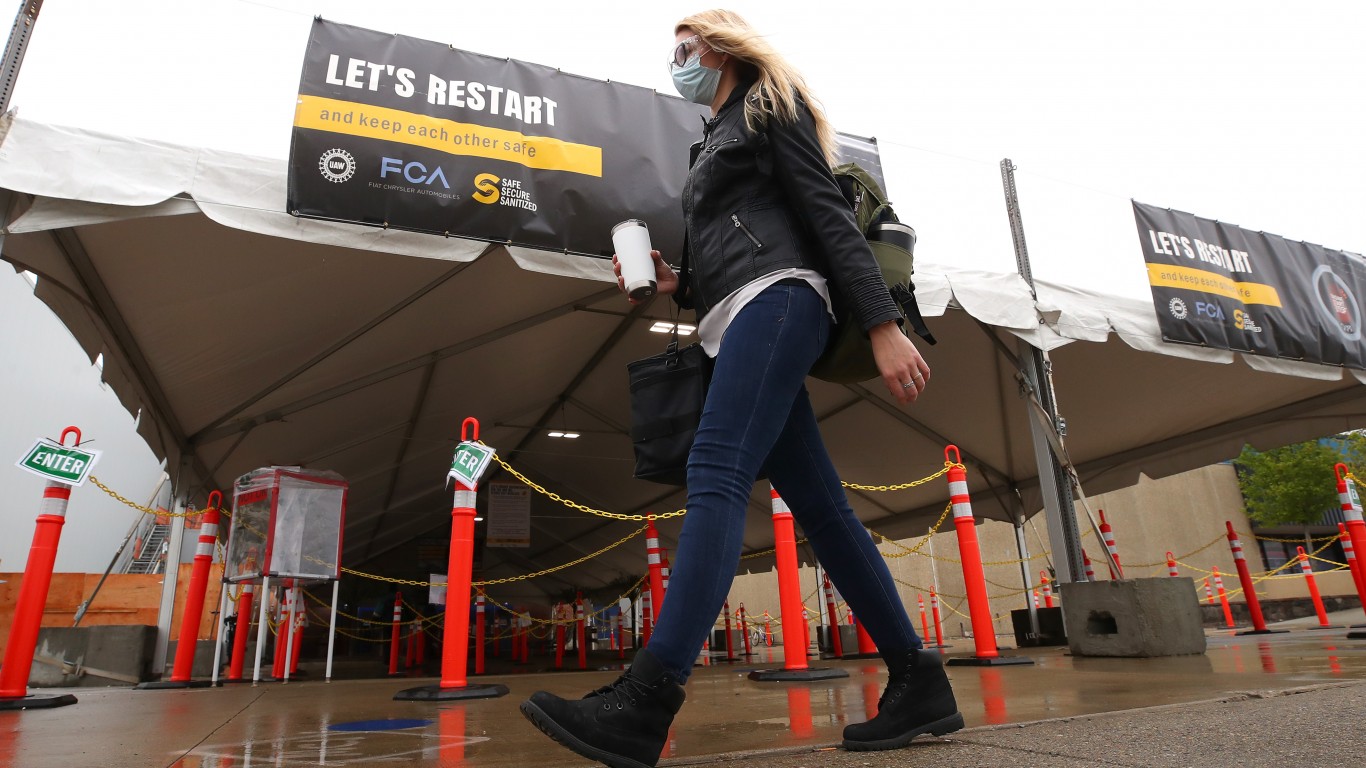
Michigan
> Cumulative COVID-19 cases as of June 11: 652 per 100,000 people — 12th highest (total: 65,182)
> COVID-19-related deaths as of June 11: 60 per 100,000 people — 7th highest (total: 5,955)
> Total tests administered as of June 11: 7,706 per 100,000 people — 13th highest (total: 770,281)
> Date of first confirmed case: 3/10/2020
> Est. peak date as of June 3: 3/27/2020 (est. 15,179 active infections)
> Population: 9,995,915
The stay-at-home order is set to expire on June 12. Retailers were allowed to open beginning June 4 and restaurants after June 8, but with capacity limits. Swimming pools, libraries, museums, and day camps for children were allowed to open as well. Groups of up to 250 people have been allowed to gather outdoors while social distancing since June 1. Indoor gatherings are limited to 10 people. Outdoor performance and sporting venues can reopen but with a capacity of no more than 500 people. Hair salons and similar personal care businesses can resume services after June 15. Office work that cannot be performed remotely can resume, as well as in-home services such as house cleaning.
[in-text-ad]
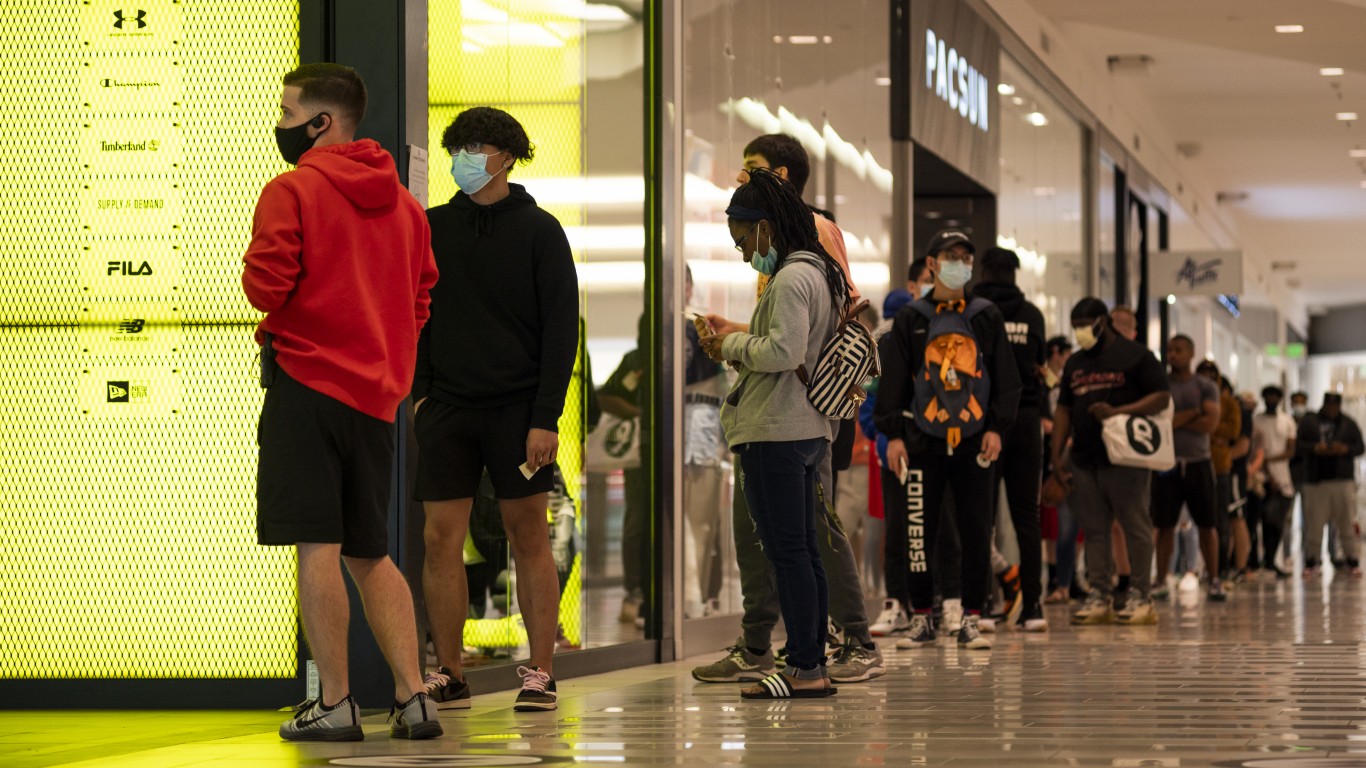
Minnesota
> Cumulative COVID-19 cases as of June 11: 514 per 100,000 people — 19th highest (total: 28,869)
> COVID-19-related deaths as of June 11: 22 per 100,000 people — 17th highest (total: 1,236)
> Total tests administered as of June 11: 6,590 per 100,000 people — 21st highest (total: 369,795)
> Date of first confirmed case: 3/6/2020
> Est. peak date as of June 3: 4/20/2020 (est. 2,847 active infections)
> Population: 5,611,179
The stay-at-home order expired on May 17. The state is now in phase 3 of reopening. The plan allows for the limited reopening of indoor dining, gyms, and entertainment venues. Restaurants can open indoor dining at 50% capacity, but reservations are required. Gyms, movie theaters, and other indoor entertainment venues can open at 25% capacity. Hair salons, barbershops, and tattoo parlors can expand to 50% capacity, but clients have to make reservations. Places of worship can expand to 50% capacity. Outdoor event venues, including sporting events, concerts, and theaters, can open at 25% capacity. Indoor social gatherings are limited to 10 people. Outdoors, people can gather in groups of 25. Public swimming pools can reopen at 50% capacity if they have a COVID-19 Preparedness Plan.
Mississippi
> Cumulative COVID-19 cases as of June 11: 619 per 100,000 people — 14th highest (total: 18,483)
> COVID-19-related deaths as of June 11: 29 per 100,000 people — 13th highest (total: 868)
> Total tests administered as of June 11: 7,157 per 100,000 people — 15th highest (total: 213,753)
> Date of first confirmed case: 3/11/2020
> Est. peak date as of June 3: 4/30/2020 (est. 1,871 active infections)
> Population: 2,986,530
Mississippi’s safer-at-home order ended June 1 and has been replaced by a safe return order, which is effective until June 15. Social gatherings must comply with social distancing requirements, with a limit of 50 people indoors and no more than 100 people outdoors. Gatherings where people cannot socially distance have limits of 20 people indoors and up to 50 people outside.
Health care procedures can return as before, but hospitals have to set aside at least 25% of capacity for COVID-19 patients. School buildings can open for summer programs. All businesses and nonprofits can open in line with health guidance, but employees are encouraged to keep working from home. Bars that do not serve food are allowed to reopen. Restaurants and bars can now have live music performances, with customers and musicians maintaining at least a 12-foot distance. Indoor places of amusement such as bowling alleys and playgrounds can open at 50% capacity.
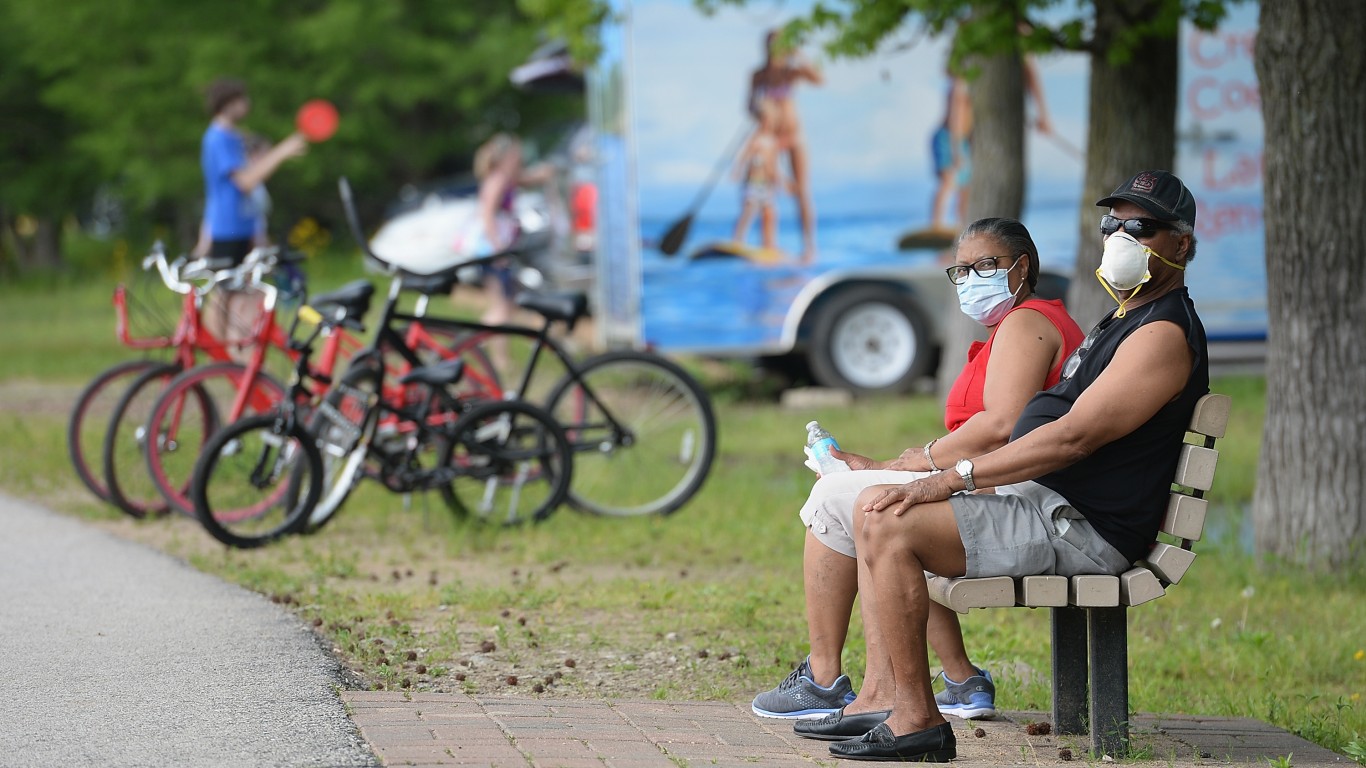
Missouri
> Cumulative COVID-19 cases as of June 11: 248 per 100,000 people — 11th lowest (total: 15,187)
> COVID-19-related deaths as of June 11: 14 per 100,000 people — 25th lowest (total: 848)
> Total tests administered as of June 11: 4,107 per 100,000 people — 12th lowest (total: 251,629)
> Date of first confirmed case: 3/7/2020
> Est. peak date as of June 3: 4/14/2020 (est. 1,757 active infections)
> Population: 6,126,452
Missouri’s stay-at-home order ended May 4. Gov. Mike Parson said on May 28 that he was extending the first phase of the reopening plan through June 15. Phase 1 requires social distancing of 6 feet. Some businesses also are required to put limits on indoor occupancy. Big events such as graduations, weddings, county fairs, summer school, and camps can take place with proper precautions.
Phase 2, which is scheduled to begin June 15, will allow the maximum number of people gathering in one place to increase to 50 people from 10. Also in phase 2, businesses such as restaurants, places of worship, gyms, and salons may boost operations to 50% capacity as long as social distancing is followed.
[in-text-ad-2]

Montana
> Cumulative COVID-19 cases as of June 11: 53 per 100,000 people — 2nd lowest (total: 561)
> COVID-19-related deaths as of June 11: 2 per 100,000 people — 3rd lowest (total: 18)
> Total tests administered as of June 11: 5,141 per 100,000 people — 19th lowest (total: 54,616)
> Date of first confirmed case: 3/13/2020
> Est. peak date as of June 3: 3/12/2020 (est. 98 active infections)
> Population: 1,062,305
The shelter-in-place order expired April 26. Phase 2 of reopening started on June 1, and gatherings are now limited to a maximum of 50 people. Also beginning on June 1, restaurants, bars, breweries distilleries, and casinos were allowed to expand to 75% capacity. Gyms, indoor group fitness classes, pools, and hot tubs can also operate at 75% capacity. Concert halls, bowling alleys, and other places of assembly can resume activities but with reduced capacity. The 24-person cap per child care facility has been lifted. Employers should still allow employees to work remotely as much as possible. Glacier National Park began to reopen certain parts of the park on June 8. Areas of the west side of the park are open for day-use only.
Nebraska
> Cumulative COVID-19 cases as of June 11: 831 per 100,000 people — 10th highest (total: 16,025)
> COVID-19-related deaths as of June 11: 10 per 100,000 people — 18th lowest (total: 195)
> Total tests administered as of June 11: 6,626 per 100,000 people — 20th highest (total: 127,830)
> Date of first confirmed case: 2/17/2020
> Est. peak date as of June 3: 5/8/2020 (est. 582 active infections)
> Population: 1,929,268
The state never issued a stay-at-home order. People returning from international travel are required to self-quarantine for 14 days. Restaurants can open in certain regions and at 50% capacity. All dining parties are restricted to no more than six people. Child care facilities can now open and have up to 15 children per room. Hair salons, nail salons, tattoo parlors, and massage therapists may reopen but can’t allow more than 10 people in, and everyone, including patrons, must wear masks. Gyms can open to either 25 people or 50% capacity.
Nebraska is now permitting youth baseball and softball teams to practice, and games may be played starting June 18. Schools can now open their weight rooms for use by student athletes. Drive-in movies can resume, but people must remain inside their cars. Parades, carnivals, dances, and beer gardens are banned until at least June 30.
[in-text-ad]
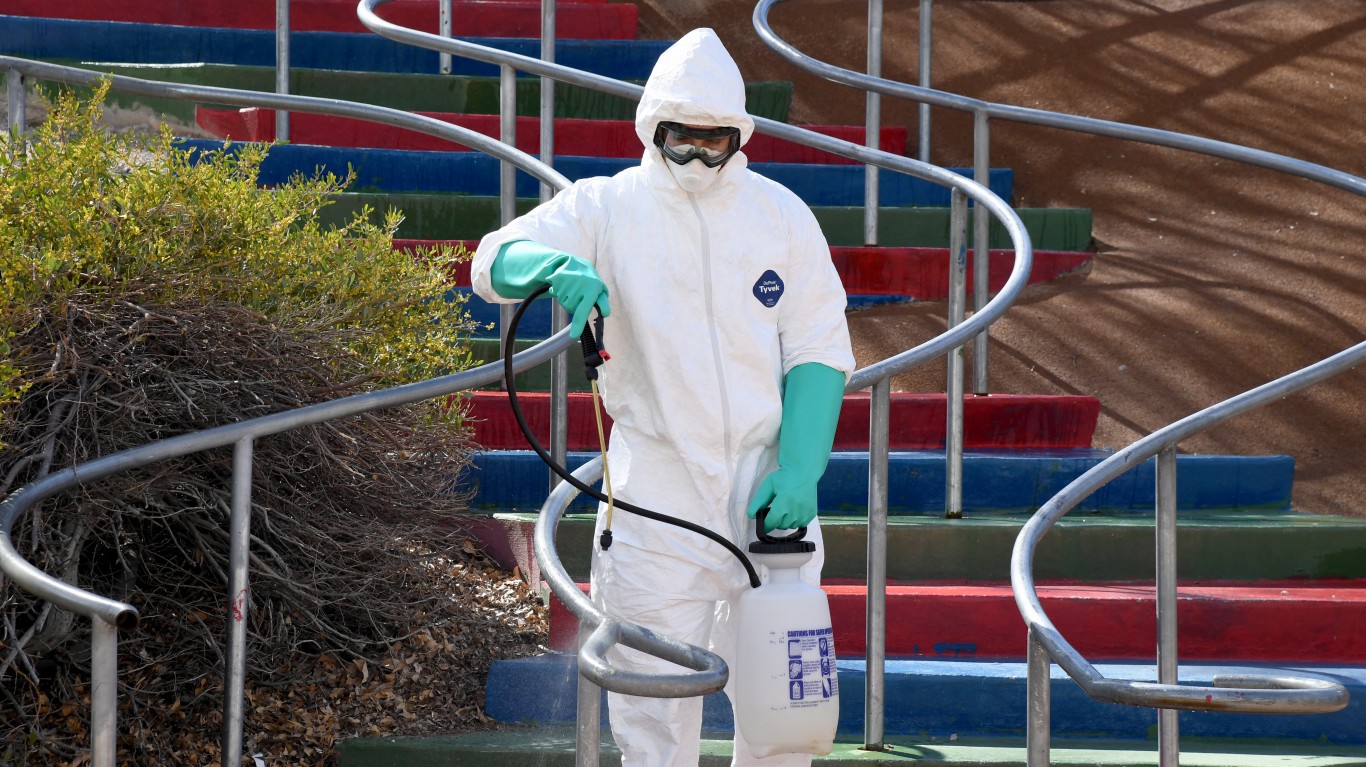
Nevada
> Cumulative COVID-19 cases as of June 11: 335 per 100,000 people — 17th lowest (total: 10,164)
> COVID-19-related deaths as of June 11: 15 per 100,000 people — 25th highest (total: 448)
> Total tests administered as of June 11: 7,088 per 100,000 people — 16th highest (total: 215,087)
> Date of first confirmed case: 3/5/2020
> Est. peak date as of June 3: 3/25/2020 (est. 1,132 active infections)
> Population: 3,034,392
The stay-at-home order expired on May 15, but some restrictions had already been lifted even before. The state began phase 2 of reopening on May 29, allowing salons and tattoo parlors to open. Pools, museums, zoos, malls, bowling alleys, movie theaters, and more were also allowed to reopen with reduced capacity.
Nevada’s lifeblood, the gaming industry, reopened on June 4. Live events such as sports, concerts, and theater performances may be held for broadcast, with no in-person spectators allowed.
Schools will reopen for summer classes and activities. Districts and schools may choose to offer summer instruction online, in-person classes, or both. All DMV offices will reopen for in-person services after June 15.

New Hampshire
> Cumulative COVID-19 cases as of June 11: 382 per 100,000 people — 24th lowest (total: 5,178)
> COVID-19-related deaths as of June 11: 22 per 100,000 people — 16th highest (total: 301)
> Total tests administered as of June 11: 6,628 per 100,000 people — 19th highest (total: 89,907)
> Date of first confirmed case: 3/2/2020
> Est. peak date as of June 3: 4/29/2020 (est. 740 active infections)
> Population: 1,356,458
An amended stay-at-home order expired on May 31. Still, people must maintain at least 6 feet distance when outside, use proper hand hygiene, and wear a mask whenever possible. Elective medical procedures have resumed. Services like salons, massage therapy centers, and tattoo shops were allowed reopen. Hotels and short-term rentals were allowed to resume service for state residents.
Beach activities are now allowed at state seacoast beaches. Some golfing restrictions have been lifted: two people from separate households can be in the same golf cart; breaks between tee times are shorter; and courses are open to out-of-state residents. Restaurants in six counties will be allowed to open at 100% capacity after June 15. Restaurants elsewhere in the state can only resume services at 50% indoor capacity. Weddings can be held after June 15, but with restrictions. Crowding should be minimized, and social distancing measures to reduce close contact should be taken.

New Jersey
> Cumulative COVID-19 cases as of June 11: 1,856 per 100,000 people — 2nd highest (total: 165,346)
> COVID-19-related deaths as of June 11: 139 per 100,000 people — the highest (total: 12,377)
> Total tests administered as of June 11: 11,325 per 100,000 people — 4th highest (total: 1,008,934)
> Date of first confirmed case: 3/4/2020
> Est. peak date as of June 3: 3/31/2020 (est. 32,287 active infections)
> Population: 8,908,520
New Jersey’s stay-at-home order was lifted on June 9. Under current rules, public parks have reopened, as well as beaches and curbside retail. Phase 2 of reopening will begin on June 15. People who can work from home should continue to do so. Museums, libraries, limited in-person government services, and gyms will be allowed to reopen. Outdoor dining and limited in-person retail can resume after June 15 as well. Hair salons and barbershops will be allowed to reopen after June 22. Nonessential retail stores can open after June 15 at 50% capacity. Indoor gatherings are allowed, but at 25% of a building’s capacity or 50 people, whichever number is lower. People can gather outside in groups of 100.
[in-text-ad-2]
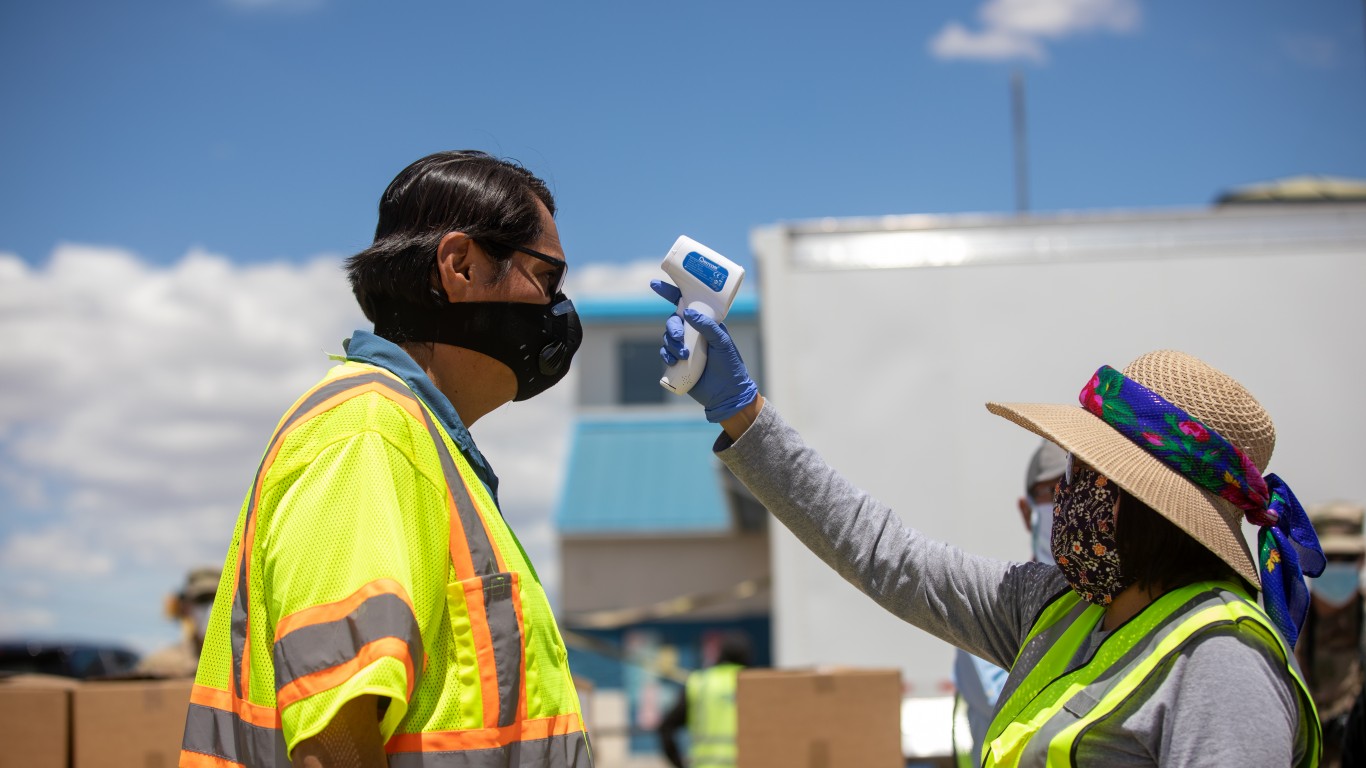
New Mexico
> Cumulative COVID-19 cases as of June 11: 441 per 100,000 people — 22nd highest (total: 9,250)
> COVID-19-related deaths as of June 11: 20 per 100,000 people — 20th highest (total: 410)
> Total tests administered as of June 11: 11,719 per 100,000 people — 3rd highest (total: 245,557)
> Date of first confirmed case: 3/11/2020
> Est. peak date as of June 3: 4/17/2020 (est. 983 active infections)
> Population: 2,095,428
A modified stay-at-home order expired on May 31. Some nonessential businesses and services, including retailers, are now allowed to reopen at 25% capacity. Gatherings of more than five people are not allowed. Retailers with large stores have to limit capacity to 20%.
Restaurants are now allowed to resume indoor seating at 50% capacity. They can in most of the state now offer limited outdoor dine-in service. Tables must be at least 6 feet apart, and each table can have no more than six customers. Gyms can also reopen and operate at 50% capacity. Malls, barbershops, and tattoo parlors can open at 25% capacity. Many state parks are now open for day use.
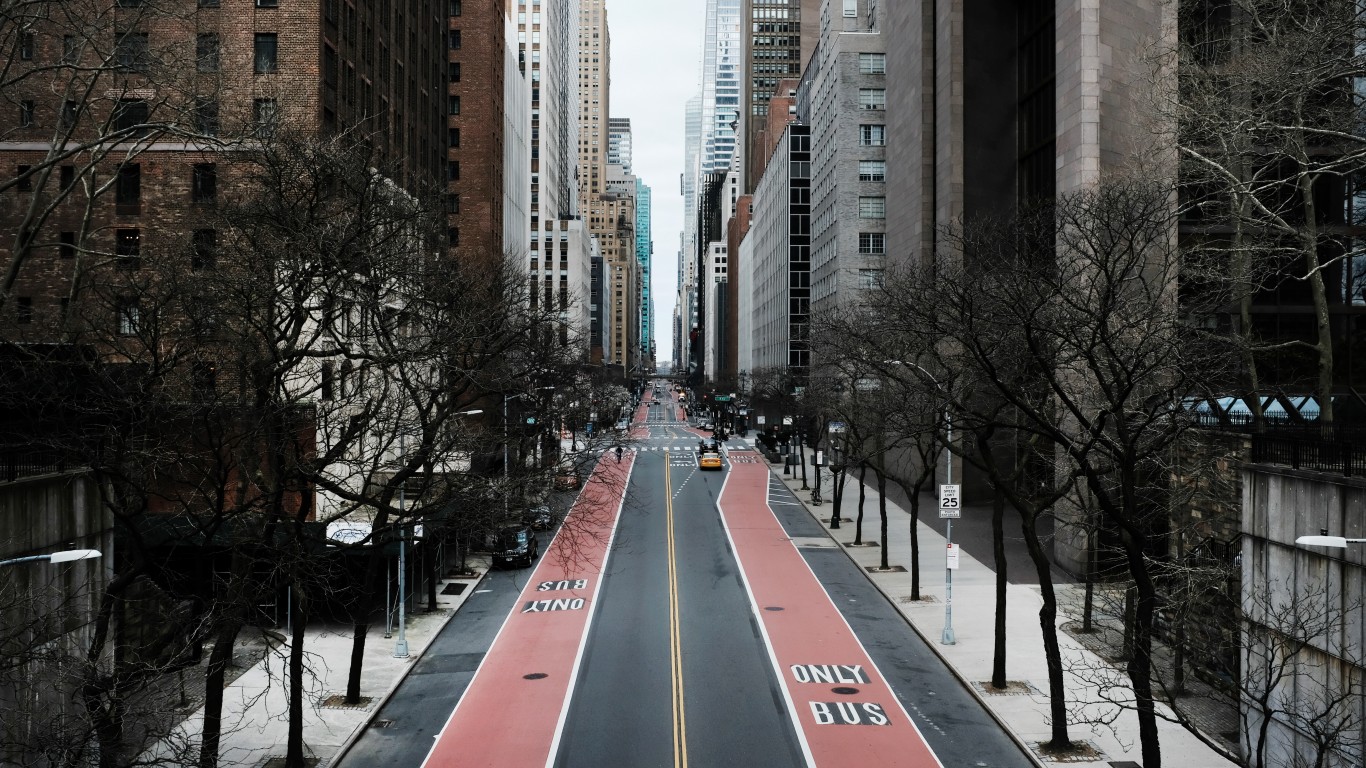
New York
> Cumulative COVID-19 cases as of June 11: 1,945 per 100,000 people — the highest (total: 380,156)
> COVID-19-related deaths as of June 11: 125 per 100,000 people — 2nd highest (total: 24,404)
> Total tests administered as of June 11: 13,653 per 100,000 people — 2nd highest (total: 2,668,166)
> Date of first confirmed case: 3/1/2020
> Est. peak date as of June 3: 3/25/2020 (est. 108,815 active infections)
> Population: 19,542,209
Though limited reopenings began in certain regions on May 15, the statewide stay-at-home order expired on May 28 with social distancing rules remaining in place. Low-risk businesses and recreational activities such as landscaping and gardening, drive-in movie theaters, and tennis can resume. Nonessential gatherings of any size are still banned. Construction, manufacturing, wholesale trade, retail (for curbside pickup only), agriculture, forestry, and fishing can resume operations.
Seven regions in the state now allow restaurants to open for outdoor dining but tables must be 6 feet apart. Businesses can deny entry to people without masks. Campgrounds and RV parks are now allowed to reopen statewide. As of May 26, veterinarian practices can reopen in all regions of the state. In-person special education instruction can take place over the summer. Schools can hold drive-in and drive-through graduation ceremonies.
[in-text-ad]
North Carolina
> Cumulative COVID-19 cases as of June 11: 368 per 100,000 people — 22nd lowest (total: 38,171)
> COVID-19-related deaths as of June 11: 10 per 100,000 people — 19th lowest (total: 1,053)
> Total tests administered as of June 11: 5,332 per 100,000 people — 21st lowest (total: 553,650)
> Date of first confirmed case: 3/3/2020
> Est. peak date as of June 3: 4/6/2020 (est. 2,132 active infections)
> Population: 10,383,620
North Carolina entered its first phase of reopening on May 8, allowing retailers to operate at 50% capacity and child care centers to reopen. The modified stay-at-home order expired on May 22, when the state entered phase 2. Under the new rules, gatherings of up to 10 people indoors and 25 people outdoors are allowed. The state also advises residents to maintain at least 6 feet of distance from others in public and wear a face mask. Restaurants are now open but must operate at 50% capacity and follow strict sanitation and social distancing guidelines. Currently, phase 2 is set to expire on June 26.
North Dakota
> Cumulative COVID-19 cases as of June 11: 387 per 100,000 people — 25th lowest (total: 2,941)
> COVID-19-related deaths as of June 11: 10 per 100,000 people — 17th lowest (total: 73)
> Total tests administered as of June 11: 10,744 per 100,000 people — 5th highest (total: 81,660)
> Date of first confirmed case: 3/11/2020
> Est. peak date as of June 3: 4/22/2020 (est. 171 active infections)
> Population: 760,077
North Dakota is one of a handful of states that never issued a statewide stay-at-home order. The order for all nonessential businesses to close ended on April 30. Some businesses, including movie theaters, gyms, salons, tattoo parlors, bars, and restaurants have been allowed to open. Bars and restaurants are now allowed to increase capacity to 75%; movie theaters are allowed to increase capacity to 65%; and fitness centers may consider resuming classes with social distancing. The recommended capacity for banquets and weddings increased to 75% of venue occupancy, but to no more than 500 people.
Ohio
> Cumulative COVID-19 cases as of June 11: 339 per 100,000 people — 18th lowest (total: 39,575)
> COVID-19-related deaths as of June 11: 21 per 100,000 people — 18th highest (total: 2,457)
> Total tests administered as of June 11: N/A
> Date of first confirmed case: 3/9/2020
> Est. peak date as of June 3: 4/20/2020 (est. 4,752 active infections)
> Population: 11,689,442
The modified stay-at-home order expired on May 29. People are required to wear face coverings when in public. Social gatherings remain limited to a maximum of 10 people.
Gyms and fitness centers are able to reopen and non-contact and limited-contact sports can resume with safety protocols in place. Public and club pools can reopen as can miniature golf, batting cages, and bowling alleys. Catering and banquet centers can reopen if tables are at least 6 feet apart and gatherings don’t exceed 300 people. Child care facilities were allowed to reopen May 31, as long as they follow safety guidelines.
Entertainment facilities such as country clubs, indoor movie theaters, outdoor playgrounds, trampoline parks, and zoos can now also open. Casinos, amusement parks, and water parks can open beginning June 19.
[in-text-ad-2]
Oklahoma
> Cumulative COVID-19 cases as of June 11: 190 per 100,000 people — 9th lowest (total: 7,480)
> COVID-19-related deaths as of June 11: 9 per 100,000 people — 16th lowest (total: 355)
> Total tests administered as of June 11: N/A
> Date of first confirmed case: 3/8/2020
> Est. peak date as of June 3: 3/29/2020 (est. 915 active infections)
> Population: 3,943,079
The state never issued a statewide stay-at-home order except for older people and those who have certain preexisting conditions. Restrictions on salons, barbers, and pet groomers have been lifted. Restaurant dining, movie theaters, gyms, houses of worship, and sporting venues have been allowed to reopen since May 1 with certain restrictions, including adhering to strict social distancing and sanitation protocols.
Phase 3 of reopening started on June 1. Businesses can now resume staffing at their work sites, but social distancing guidelines must be followed. Businesses that were operating by appointment only can now start accepting walk-ins. Summer camps can open in line with safety guidelines. Limited visitation to hospitals may resume.
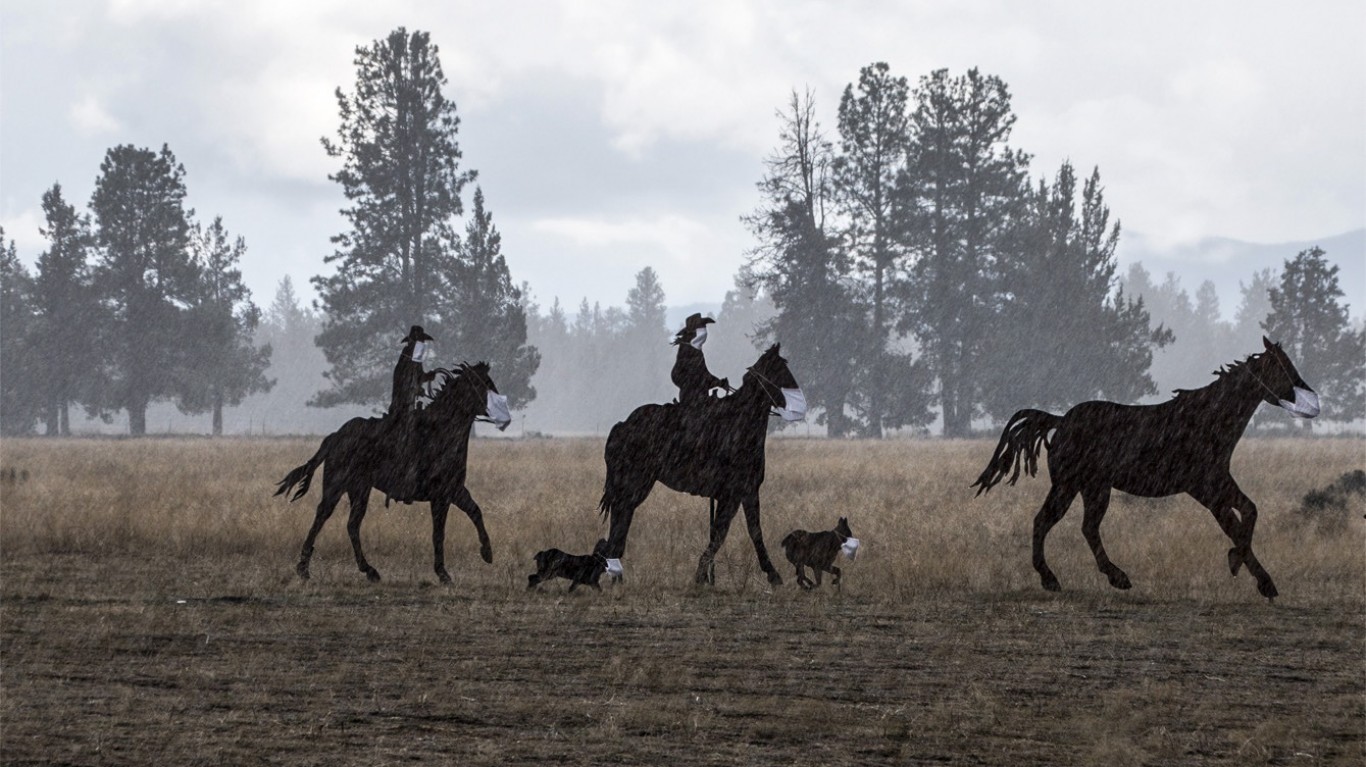
Oregon
> Cumulative COVID-19 cases as of June 11: 121 per 100,000 people — 4th lowest (total: 5,060)
> COVID-19-related deaths as of June 11: 4 per 100,000 people — 5th lowest (total: 169)
> Total tests administered as of June 11: 3,737 per 100,000 people — 9th lowest (total: 156,605)
> Date of first confirmed case: 2/28/2020
> Est. peak date as of June 3: 4/5/2020 (est. 362 active infections)
> Population: 4,190,713
A stay-at-home order is in effect until further notice. Counties can begin lifting some restrictions when they meet certain requirements and must stay in phase 1 of the reopening for at least three weeks. Some counties began phase 2 on June 5. In phase 2, gatherings would be limited to 50 people indoors and 100 people outdoors, and restaurants and bars could extend their curfews to midnight. Movie theaters and large venues would be allowed to expand their occupancy to up to 250 people. Employees may begin a limited return to indoor workplaces. However, working from home is still recommended.
Statewide, zoos, gardens and museums can now open in a limited manner, and professional and collegiate sports teams can resume training with added safety precautions.
[in-text-ad]
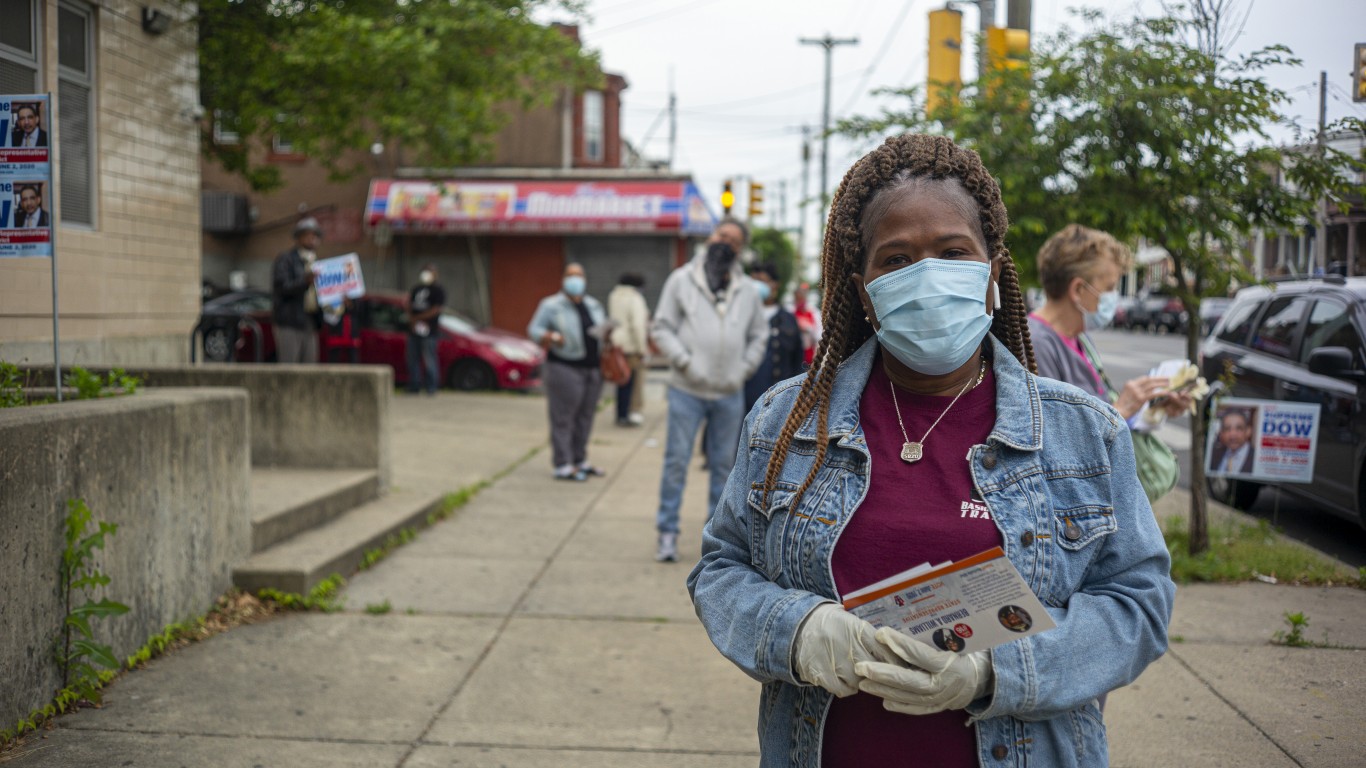
Pennsylvania
> Cumulative COVID-19 cases as of June 11: 604 per 100,000 people — 16th highest (total: 77,313)
> COVID-19-related deaths as of June 11: 48 per 100,000 people — 9th highest (total: 6,113)
> Total tests administered as of June 11: N/A
> Date of first confirmed case: 3/6/2020
> Est. peak date as of June 3: 4/11/2020 (est. 13,278 active infections)
> Population: 12,807,060
The stay-at-home order expired on June 4 for all counties, though some less-affected areas in the state reopened on May 29. Social distancing and wearing masks are required when outdoors. Working remotely is strongly encouraged, and large recreational gatherings are limited to a maximum of 250 people.
Some counties now allow outdoor dining. Professional sports teams can practice and play without fans in certain counties if they have developed a COVID-19 safety plan. All state park beaches are open. State park pools will remain closed until at least June 13.

Rhode Island
> Cumulative COVID-19 cases as of June 11: 1,490 per 100,000 people — 4th highest (total: 15,756)
> COVID-19-related deaths as of June 11: 77 per 100,000 people — 5th highest (total: 812)
> Total tests administered as of June 11: 17,367 per 100,000 people — the highest (total: 183,622)
> Date of first confirmed case: 3/1/2020
> Est. peak date as of June 3: 5/5/2020 (est. 1,650 active infections)
> Population: 1,057,315
The stay-at-home order expired on May 8. The state entered phase 2 of its reopening plan on June 1. Social gatherings are limited to 15 people. Offices can open but to no more than 33% capacity. Working from home, though, is still encouraged. State park and beaches are now open, but capacity is limited, and people must stay at least 6 feet apart.
Malls, hair salons, barbershops, and other businesses that offer personal services can reopen with restrictions as well. Gyms, fitness studios, and small group fitness classes are allowed to reopen but with limited capacity. Communal areas are to remain closed, and 6-foot social distancing must be established between equipment.
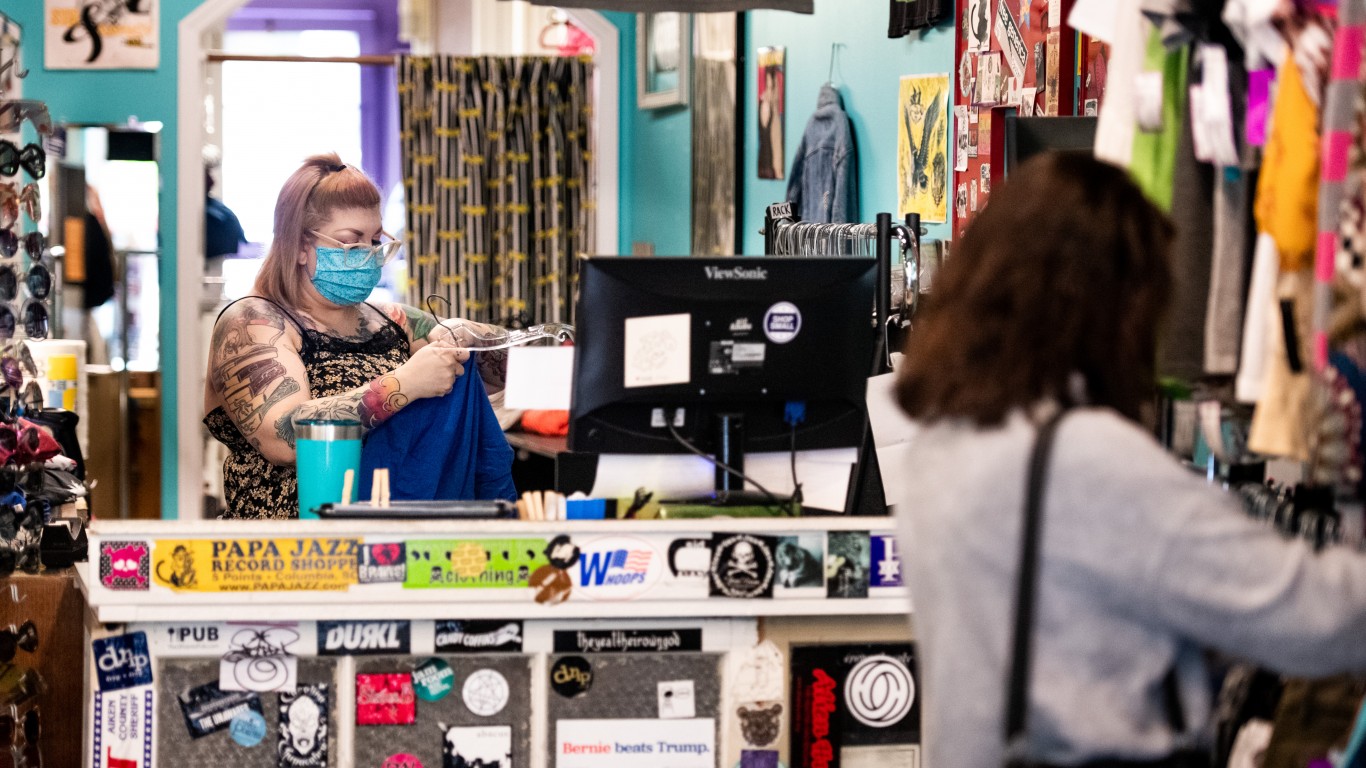
South Carolina
> Cumulative COVID-19 cases as of June 11: 310 per 100,000 people — 14th lowest (total: 15,759)
> COVID-19-related deaths as of June 11: 11 per 100,000 people — 21st lowest (total: 575)
> Total tests administered as of June 11: 5,141 per 100,000 people — 18th lowest (total: 261,377)
> Date of first confirmed case: 3/6/2020
> Est. peak date as of June 3: 4/15/2020 (est. 1,203 active infections)
> Population: 5,084,127
The stay-at-home order expired on May 4. Orders for out-of-state visitors to quarantine have also expired. Retail stores are under instructions to operate at limited capacity. Residents are encouraged, but are no longer required by law, to work from home. Restaurants can choose to reopen for limited dine-in services if they follow state guidelines, including limiting indoor occupancy to 50%. Outdoor customer dining services are also allowed. Youth and adult sports leagues started practicing on May 30, and competition will be permitted to resume June 15.
[in-text-ad-2]

South Dakota
> Cumulative COVID-19 cases as of June 11: 635 per 100,000 people — 13th highest (total: 5,604)
> COVID-19-related deaths as of June 11: 8 per 100,000 people — 13th lowest (total: 69)
> Total tests administered as of June 11: 6,879 per 100,000 people — 17th highest (total: 60,685)
> Date of first confirmed case: 3/10/2020
> Est. peak date as of June 3: 4/21/2020 (est. 234 active infections)
> Population: 882,235
The state never issued a statewide stay-at-home order, but it did institute some restrictions on gatherings and businesses. An order that required state residents to observe social distancing and CDC-recommended hygiene practices expired on May 31, but the state of emergency has been extended until December 30.
Businesses are now allowed to reopen if the surrounding area has reported a downward trend in cases for two weeks. Employees can now be called back to the office, though administrative leave is allowed for those who cannot come in and cannot work remotely.

Tennessee
> Cumulative COVID-19 cases as of June 11: 412 per 100,000 people — 24th highest (total: 27,869)
> COVID-19-related deaths as of June 11: 6 per 100,000 people — 10th lowest (total: 436)
> Total tests administered as of June 11: 7,808 per 100,000 people — 12th highest (total: 528,635)
> Date of first confirmed case: 3/5/2020
> Est. peak date as of June 3: 3/23/2020 (est. 937 active infections)
> Population: 6,770,010
The stay-at-home order expired on April 30. A safer-at-home order was in effect until May 29. Many businesses have been allowed to open in the meanwhile. Restaurants can offer in-person but limited-capacity dining. Noncontact sports, like baseball, golf, or tennis, were allowed to resume on May 22, as was higher education.
Groups of up to 50 people can now participate in social and recreational gatherings if they practice social distancing. Nursing homes and long-term care facilities are still closed to visitors, but will reopen June 15. The most populated areas of the state will decide when to reopen on their own.
[in-text-ad]
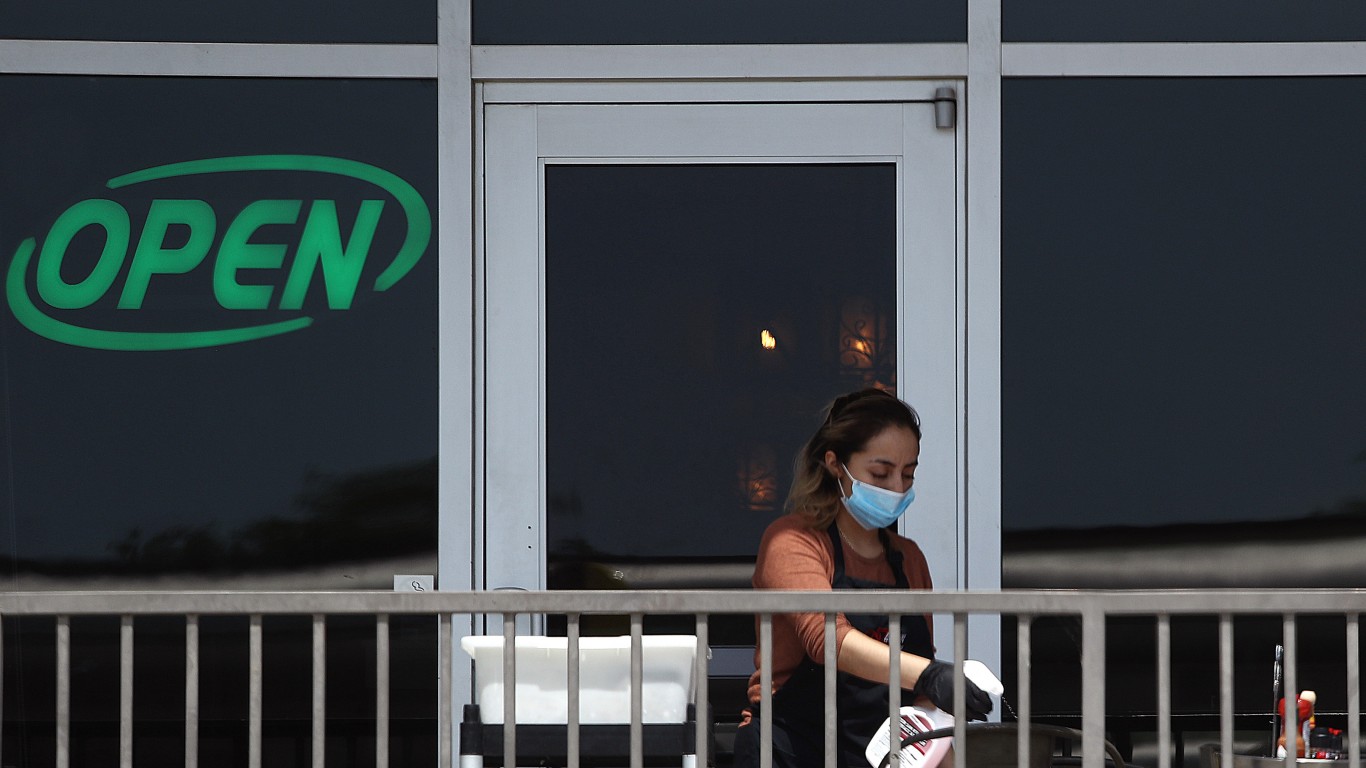
Texas
> Cumulative COVID-19 cases as of June 11: 278 per 100,000 people — 13th lowest (total: 79,757)
> COVID-19-related deaths as of June 11: 7 per 100,000 people — 11th lowest (total: 1,885)
> Total tests administered as of June 11: 4,045 per 100,000 people — 11th lowest (total: 1,161,087)
> Date of first confirmed case: 2/12/2020
> Est. peak date as of June 3: 4/26/2020 (est. 4,656 active infections)
> Population: 28,701,845
The stay-at-home order expired on April 30. All air travel restrictions, including mandatory quarantines for out-of-state travelers, have been lifted. Zoos and water parks are allowed to reopen with limited capacity. Bars, as well as aquariums and natural caverns, barbershops, hair salons, and tanning salons are also allowed to resume operations. Restaurants can expand their occupancy to 75% after June 12. Amusement parks and carnivals in counties with more than 1,000 confirmed positive cases can open at 50% capacity after June 19.
Gyms reopened starting May 18 at 25% occupancy, and recreational sports programs were allowed to start May 31. Pro sports events are now allowed with 25% capacity for outdoor venues. Recreational sports practices for adults have resumed, but games and competitions can begin June 15.
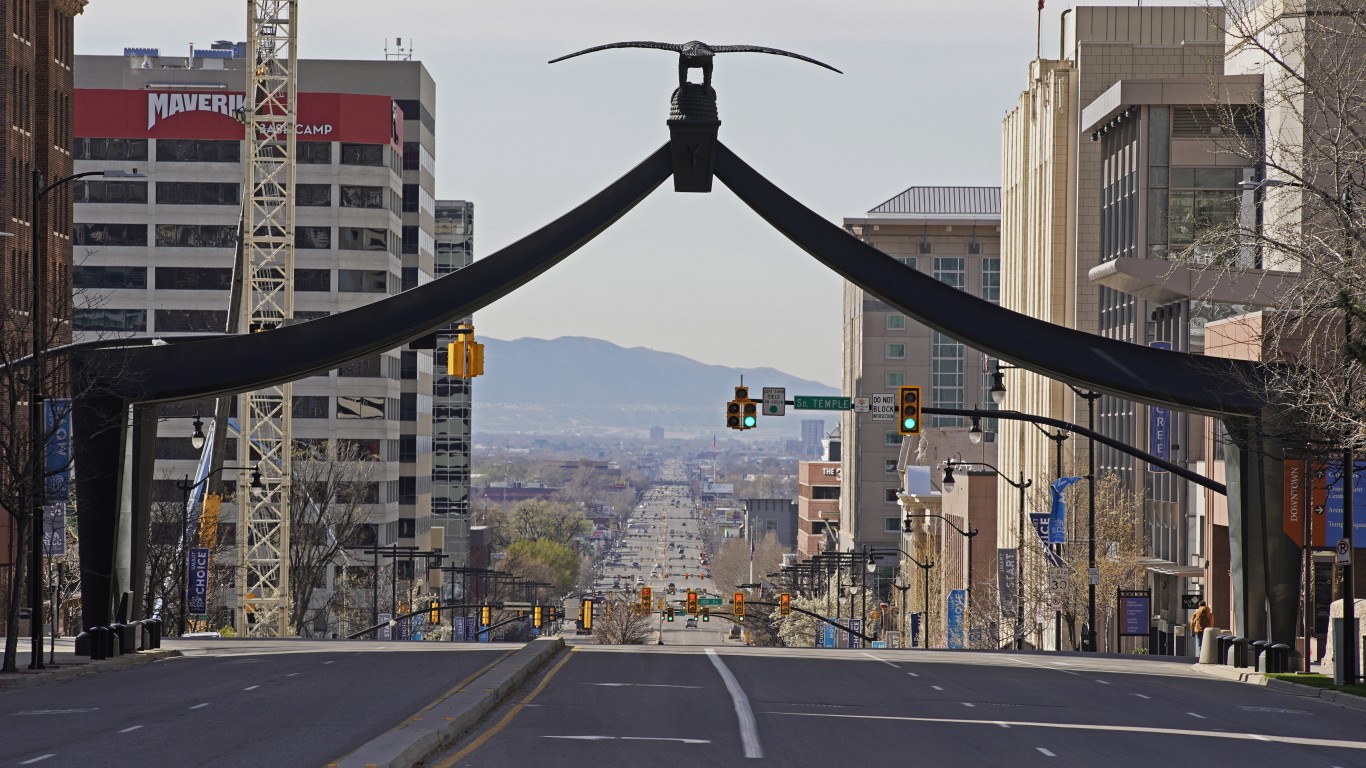
Utah
> Cumulative COVID-19 cases as of June 11: 407 per 100,000 people — 25th highest (total: 12,864)
> COVID-19-related deaths as of June 11: 4 per 100,000 people — 6th lowest (total: 128)
> Total tests administered as of June 11: 7,901 per 100,000 people — 11th highest (total: 249,760)
> Date of first confirmed case: 2/25/2020
> Est. peak date as of June 3: 6/1/2020 (est. 412 active infections)
> Population: 3,161,105
The state never issued a statewide stay-at-home order. The stay safe, stay home directive expired on May 1. In-restaurant dining, gyms, and salons can now open. Gatherings of up to 20 people are allowed. Statewide restrictions on elective surgeries and procedures were lifted as of April 21.
Malls and national parks can reopen under tight restrictions. Hours may vary and occupancy might be limited. People are still encouraged to avoid nonessential travel. College campuses may be open for in-person classes with increased cleaning and hygiene regimen.
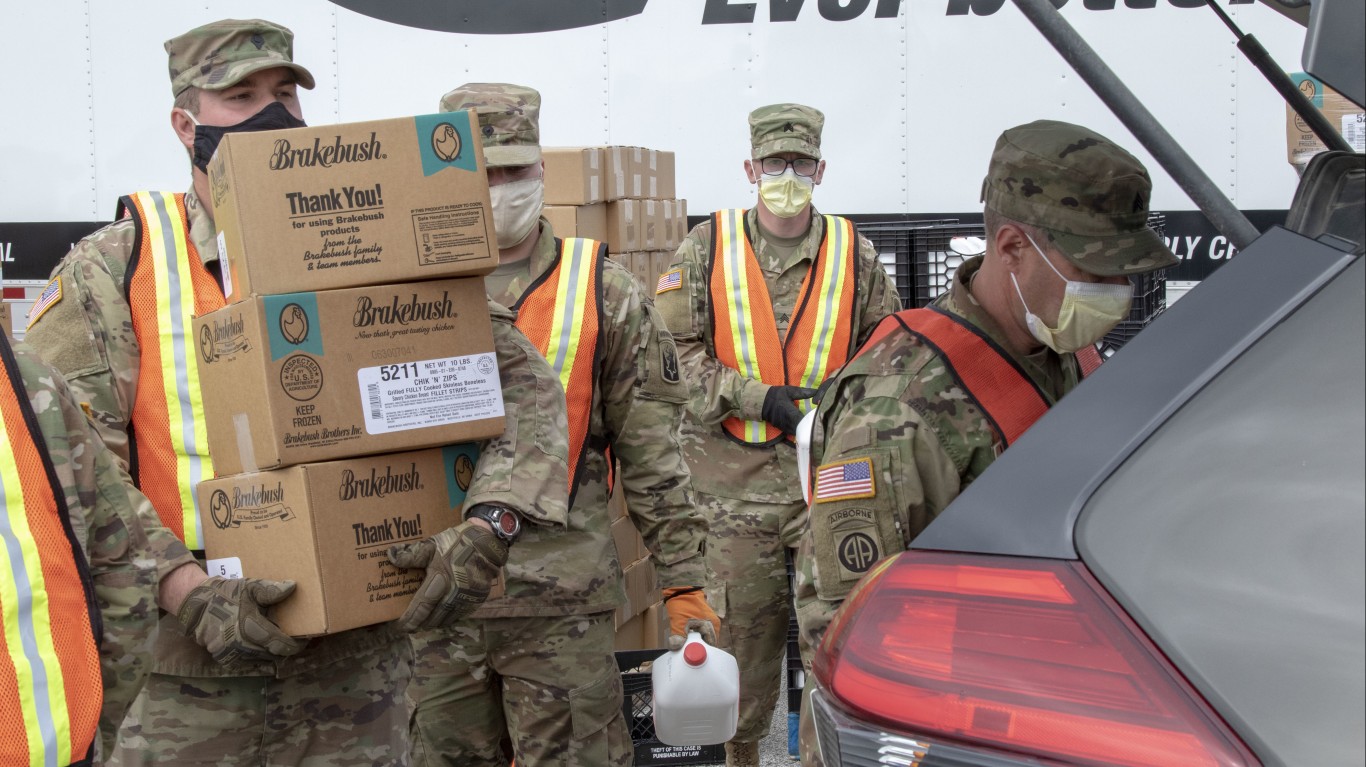
Vermont
> Cumulative COVID-19 cases as of June 11: 177 per 100,000 people — 7th lowest (total: 1,110)
> COVID-19-related deaths as of June 11: 9 per 100,000 people — 15th lowest (total: 55)
> Total tests administered as of June 11: 7,538 per 100,000 people — 14th highest (total: 47,209)
> Date of first confirmed case: 3/7/2020
> Est. peak date as of June 3: 3/17/2020 (est. 156 active infections)
> Population: 626,299
The stay-at-home order expired on May 15. The state of emergency was extended until June 15. Everyone has to work remotely when possible. As of May 11, construction has been fully allowed as long as safety measures — wearing masks and practicing good hygiene — are followed. Retail and lodging businesses can also start reopening. Hair salons and barbershops can reopen but by appointment and with limits on occupancy. Transactions must be cashless and touchless, and owners must keep a customer log in case contact tracing is needed later. Restaurants and bars have been allowed to open with limited outdoor and indoor seating.
Travel restrictions have been loosened. People in counties in New England and upstate New York with 400 or fewer cases per 1 million people can come to Vermont without having to self-quarantine. Low-contact sports such as soccer, baseball, and lacrosse can resume after June 15. Crowds cannot be bigger than 25 people.
[in-text-ad-2]
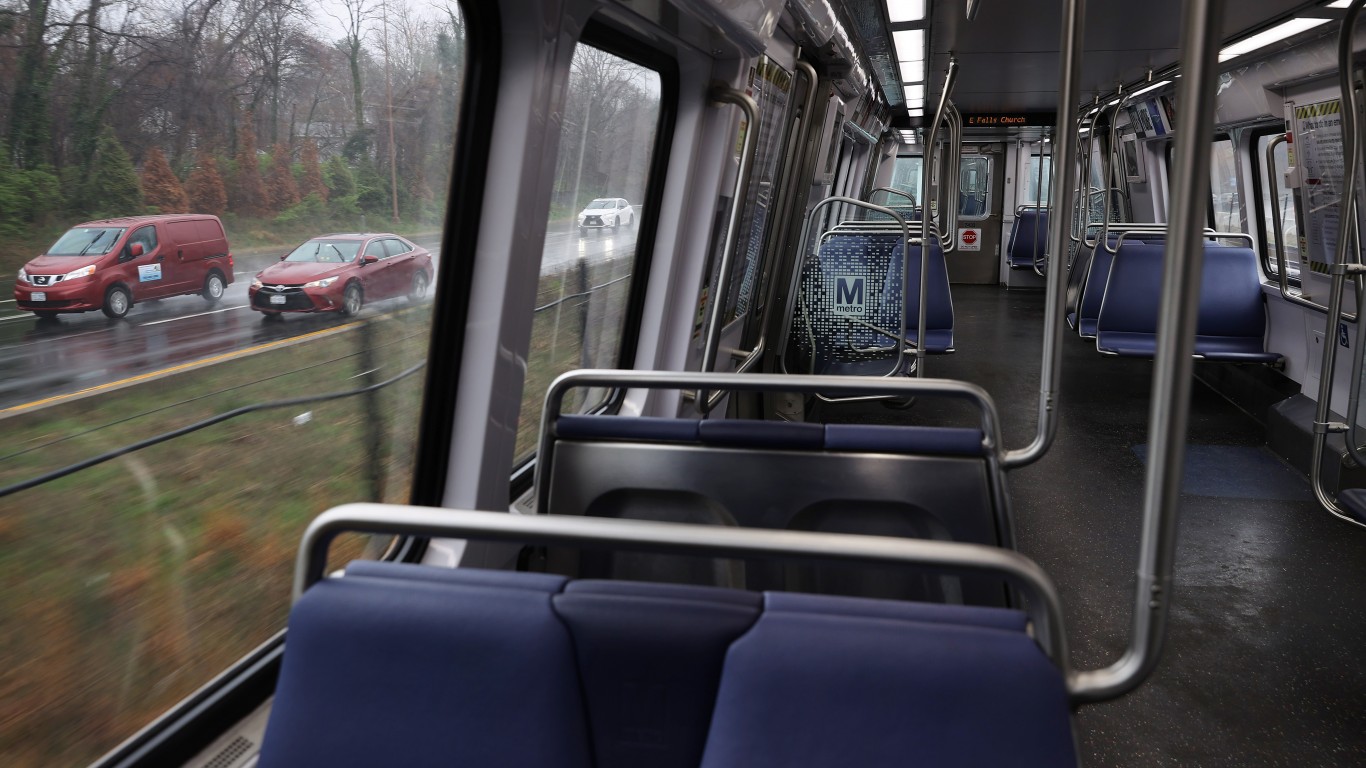
Virginia
> Cumulative COVID-19 cases as of June 11: 618 per 100,000 people — 15th highest (total: 52,647)
> COVID-19-related deaths as of June 11: 18 per 100,000 people — 21st highest (total: 1,520)
> Total tests administered as of June 11: 4,755 per 100,000 people — 15th lowest (total: 405,025)
> Date of first confirmed case: 3/7/2020
> Est. peak date as of June 3: 4/13/2020 (est. 3,625 active infections)
> Population: 8,517,685
A stay-at-home order was in effect until June 10. All counties were allowed to begin reopening as of May 28. The state is currently in phase 2 of reopening. (The City of Richmond, however, will enter phase 2 on June 12.) Restaurants can provide indoor dining at 50% occupancy, and fitness centers can open indoor areas at 30% occupancy. Museums, zoos, aquariums, gardens, and outdoor sporting and performance venues can open with restrictions. Swimming pools may expand operations to indoor and outdoor exercise. Diving and swimming instruction can resume as well in phase 2.
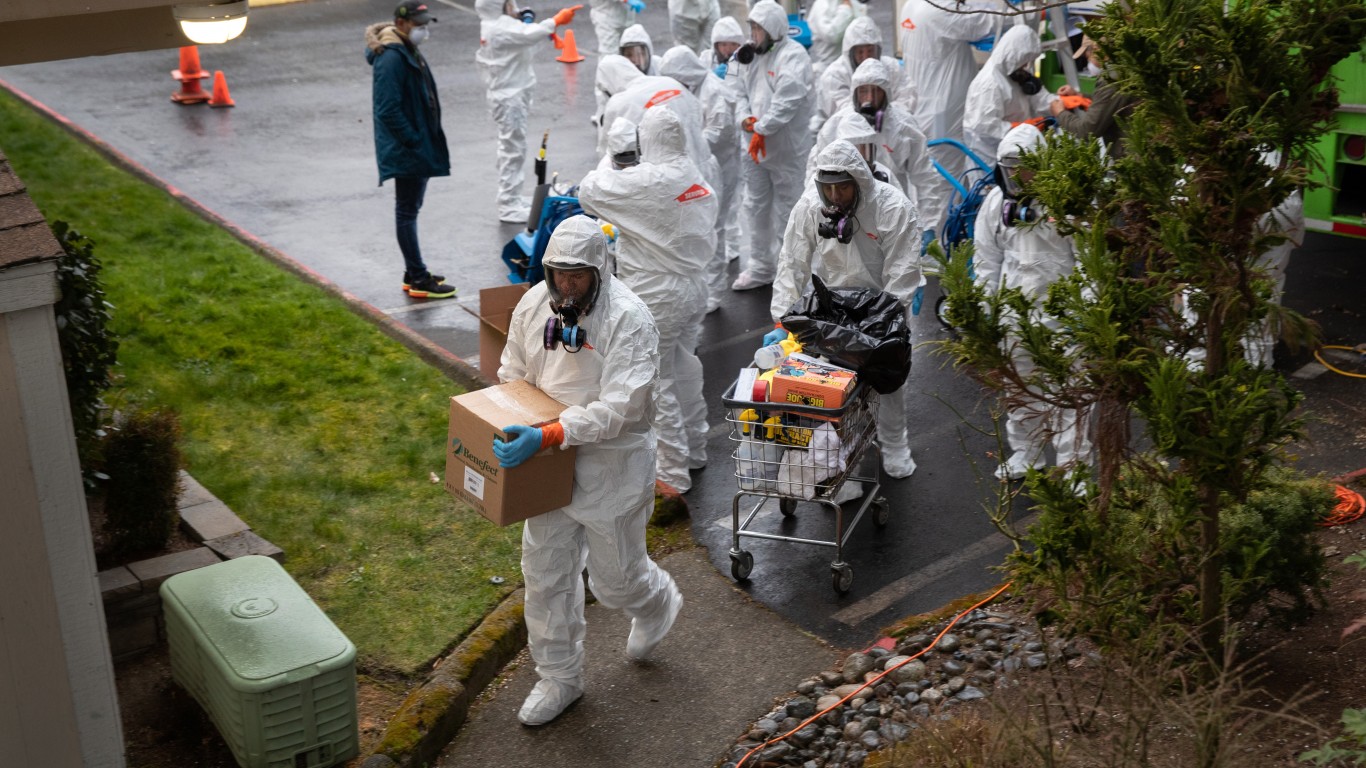
Washington
> Cumulative COVID-19 cases as of June 11: 327 per 100,000 people — 16th lowest (total: 24,642)
> COVID-19-related deaths as of June 11: 16 per 100,000 people — 22nd highest (total: 1,190)
> Total tests administered as of June 11: 5,512 per 100,000 people — 22nd lowest (total: 415,342)
> Date of first confirmed case: 1/21/2020
> Est. peak date as of June 3: 3/24/2020 (est. 2,770 active infections)
> Population: 7,535,591
A stay-at-home, stay healthy order was in effect until May 31 and has been replaced since by a Safe Start reopening plan. Most of the state’s counties are in phase 2 of reopening, in which restaurants, salons, and stores can open in a limited capacity. In-person real estate activities such as sales and appraisals with up to three people and fitness and training services have been allowed to resume since May 19 in counties that are in phase 2 of reopening.
As of June 9, there were five counties in phase 1, 25 counties in phase 2 and eight counties in phase 3. In phase 3, people are allowed to gather outside in groups of no more than 50 people, recreational facilities can open at 50% capacity, nonessential travel can resume, restaurants can expand capacity to 75%, bars can open at 25% capacity, and movie theaters can open at 50% capacity.
[in-text-ad]
West Virginia
> Cumulative COVID-19 cases as of June 11: 121 per 100,000 people — 5th lowest (total: 2,193)
> COVID-19-related deaths as of June 11: 5 per 100,000 people — 7th lowest (total: 85)
> Total tests administered as of June 11: 6,629 per 100,000 people — 18th highest (total: 119,716)
> Date of first confirmed case: 3/17/2020
> Est. peak date as of June 3: 4/6/2020 (est. 224 active infections)
> Population: 1,805,832
The stay-at-home order expired on May 3. Residents are encouraged but not required to stay inside. State park cabins, museums, and zoos have been allowed to reopen. Bars can serve at 50% capacity. Spas and massage businesses are open. So are swimming pools, bowling alleys, pool halls, roller rinks, other indoor amusement venues, and movie theaters. Social gatherings in public are now limited to 100 people, up from 25.
Low-contact outdoor youth sports and little league organizations can now resume practices, and sports games can start after June 22. Sports venues and facilities can open as well. Open-air concerts, fairs, and festivals will be allowed to take place after July 1.
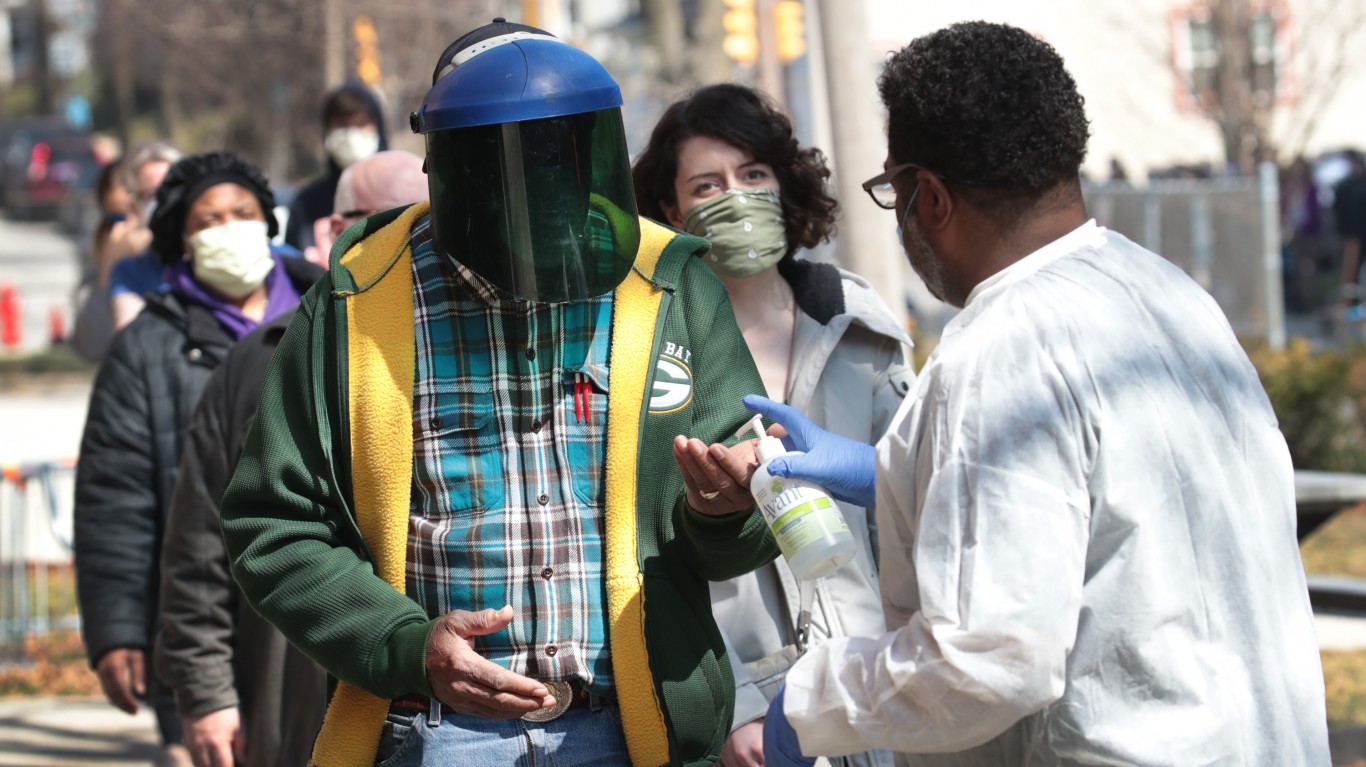
Wisconsin
> Cumulative COVID-19 cases as of June 11: 371 per 100,000 people — 23rd lowest (total: 21,593)
> COVID-19-related deaths as of June 11: 12 per 100,000 people — 22nd lowest (total: 671)
> Total tests administered as of June 11: N/A
> Date of first confirmed case: 2/5/2020
> Est. peak date as of June 3: 3/30/2020 (est. 1,312 active infections)
> Population: 5,813,568
A stay-at-home order was supposed to be in effect until May 26, but the state’s Supreme Court struck it down on May 13. All restrictions were then lifted. Some districts have imposed their own stay-at-home orders, though most have already lapsed.
Wyoming
> Cumulative COVID-19 cases as of June 11: 170 per 100,000 people — 6th lowest (total: 980)
> COVID-19-related deaths as of June 11: 3 per 100,000 people — 4th lowest (total: 18)
> Total tests administered as of June 11: 5,330 per 100,000 people — 20th lowest (total: 30,795)
> Date of first confirmed case: 3/11/2020
> Est. peak date as of June 3: 5/8/2020 (est. 93 active infections)
> Population: 577,737
The state never issued a statewide stay-at-home order. Gyms, barbershops, hair salons, other personal care services, and elective surgeries have resumed operations with limits on the number of customers in the facility. Restaurants can start offering indoor and outdoor dining. Movie theaters and performance venues can reopen with no more than 25 people. Gyms can reopen locker rooms, offer personal training, as well as group classes for up to 20 participants. Child care facilities can allow up to 25 people in a classroom.
Roads, hiking trails, and rock climbing routes at the popular Devil’s Tower National Monument are now open to the public, though services are limited. Outdoor gatherings of up to 250 people have been allowed since June 1, but people must practice social distancing.
Want to Retire Early? Start Here (Sponsor)
Want retirement to come a few years earlier than you’d planned? Or are you ready to retire now, but want an extra set of eyes on your finances?
Now you can speak with up to 3 financial experts in your area for FREE. By simply clicking here you can begin to match with financial professionals who can help you build your plan to retire early. And the best part? The first conversation with them is free.
Click here to match with up to 3 financial pros who would be excited to help you make financial decisions.
Have questions about retirement or personal finance? Email us at [email protected]!
By emailing your questions to 24/7 Wall St., you agree to have them published anonymously on a673b.bigscoots-temp.com.
By submitting your story, you understand and agree that we may use your story, or versions of it, in all media and platforms, including via third parties.
Thank you for reading! Have some feedback for us?
Contact the 24/7 Wall St. editorial team.

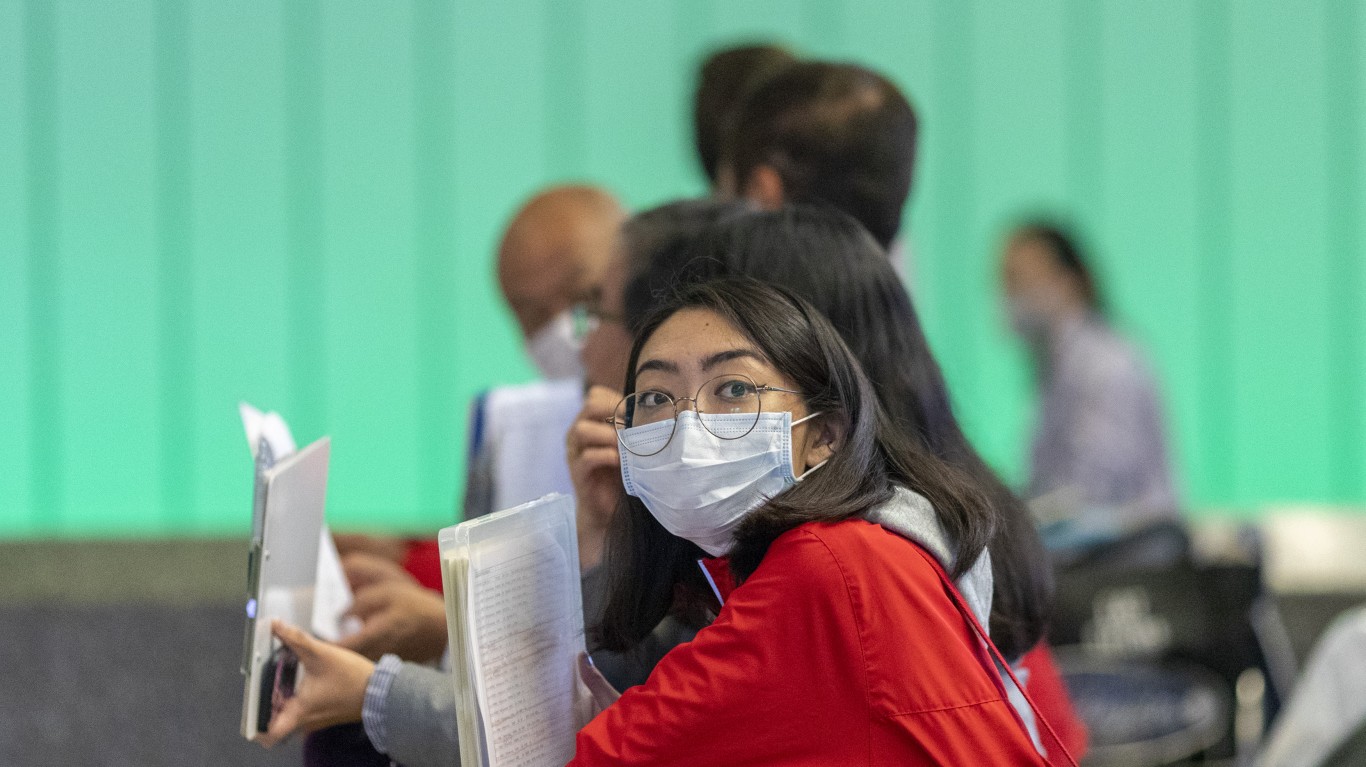 24/7 Wall St.
24/7 Wall St. 24/7 Wall St.
24/7 Wall St.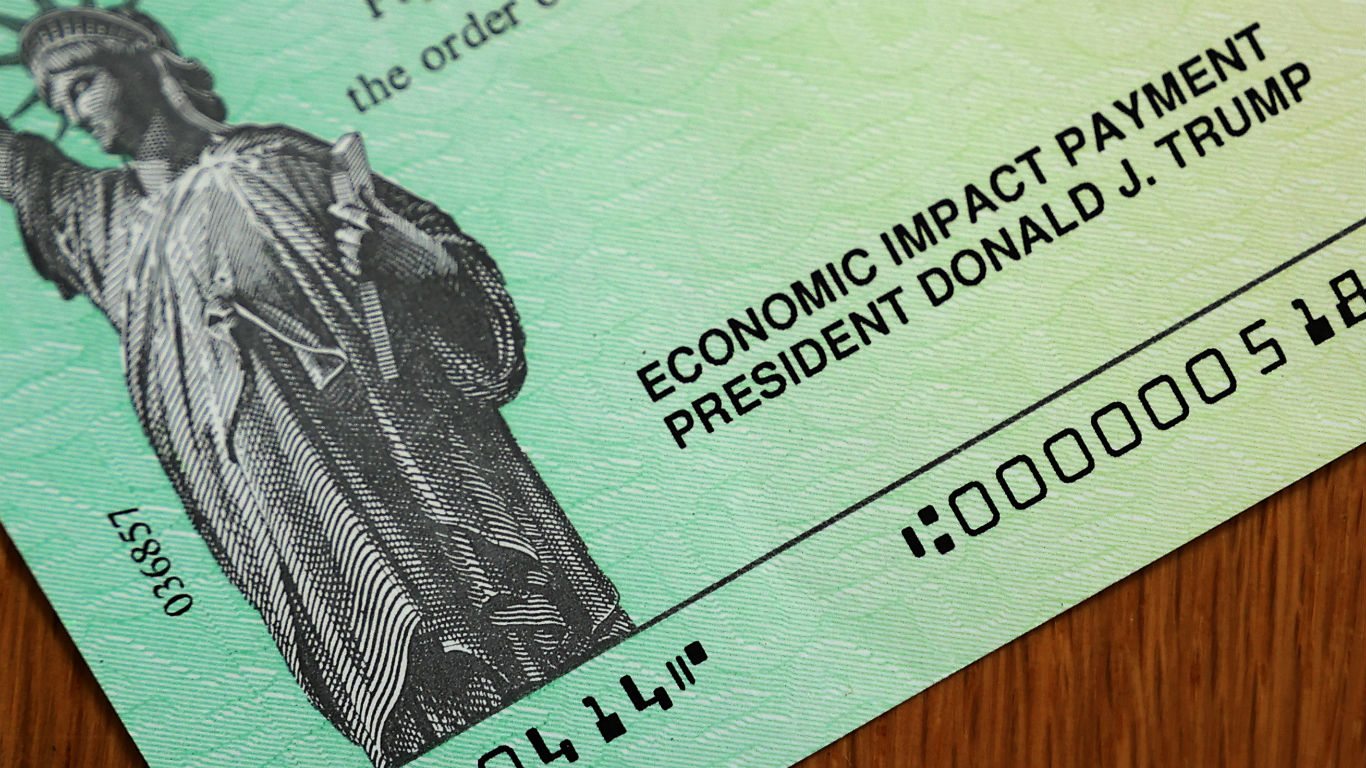 24/7 Wall St.
24/7 Wall St.
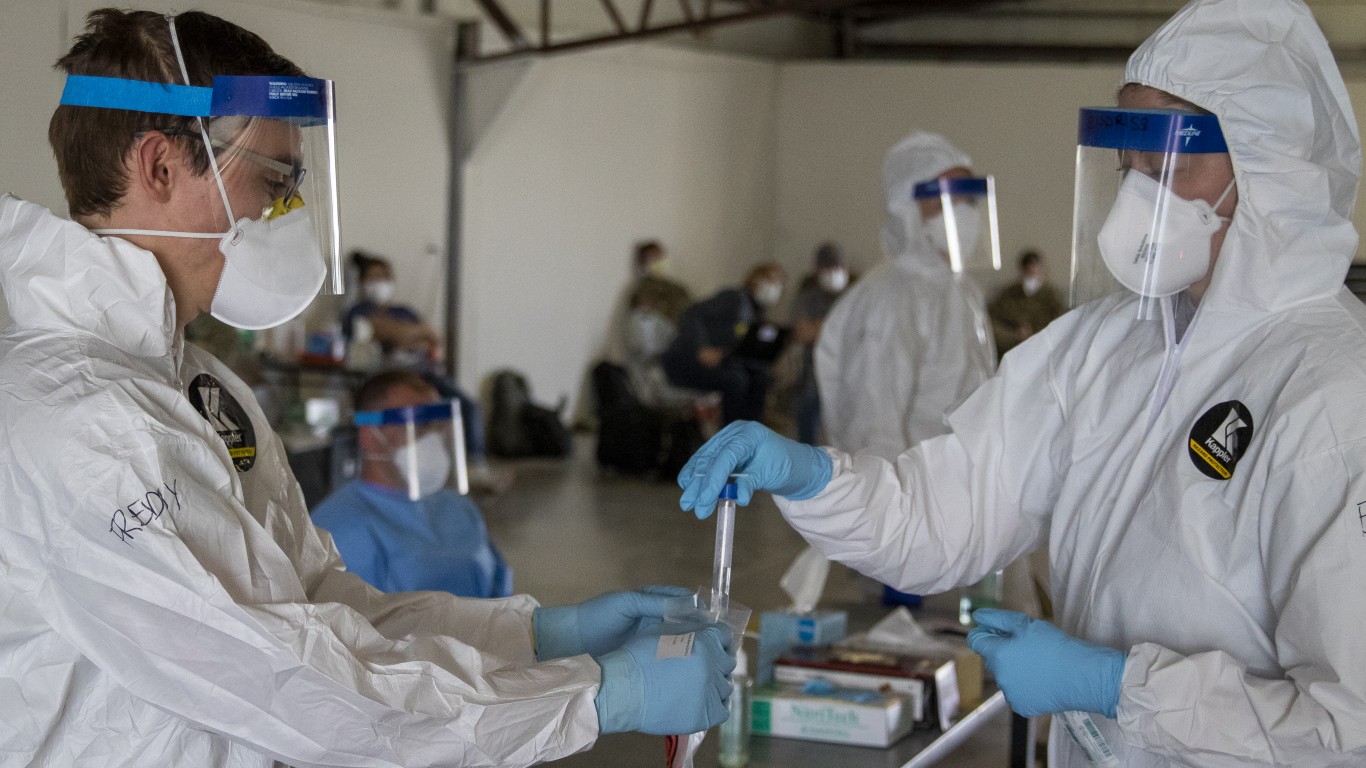

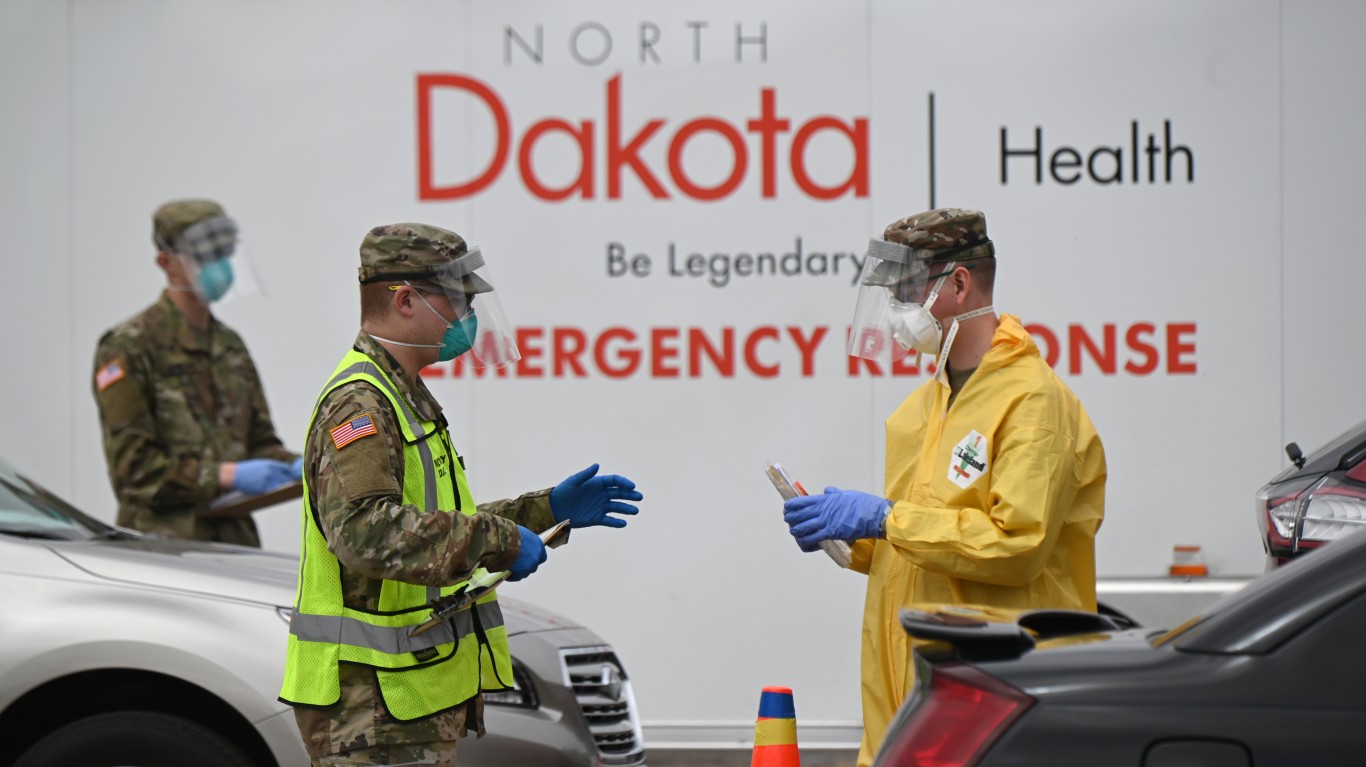
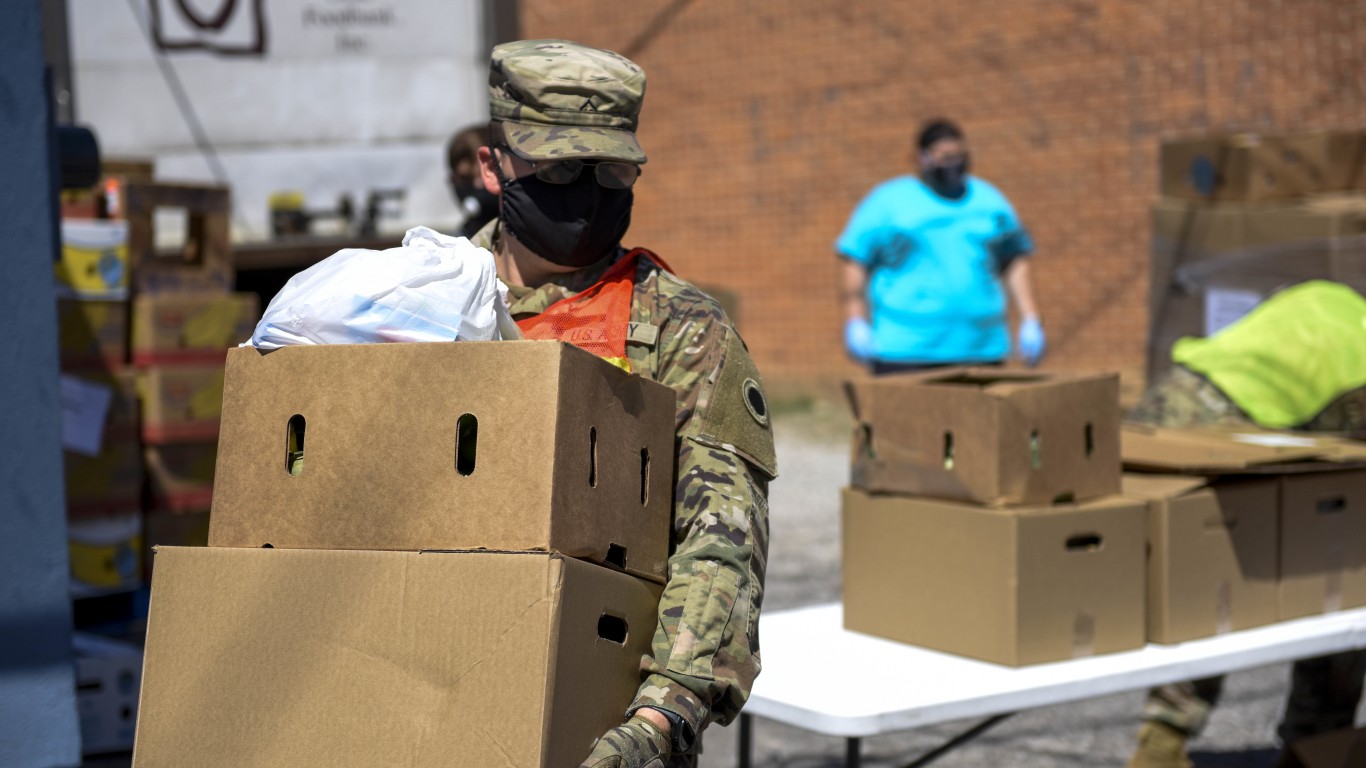
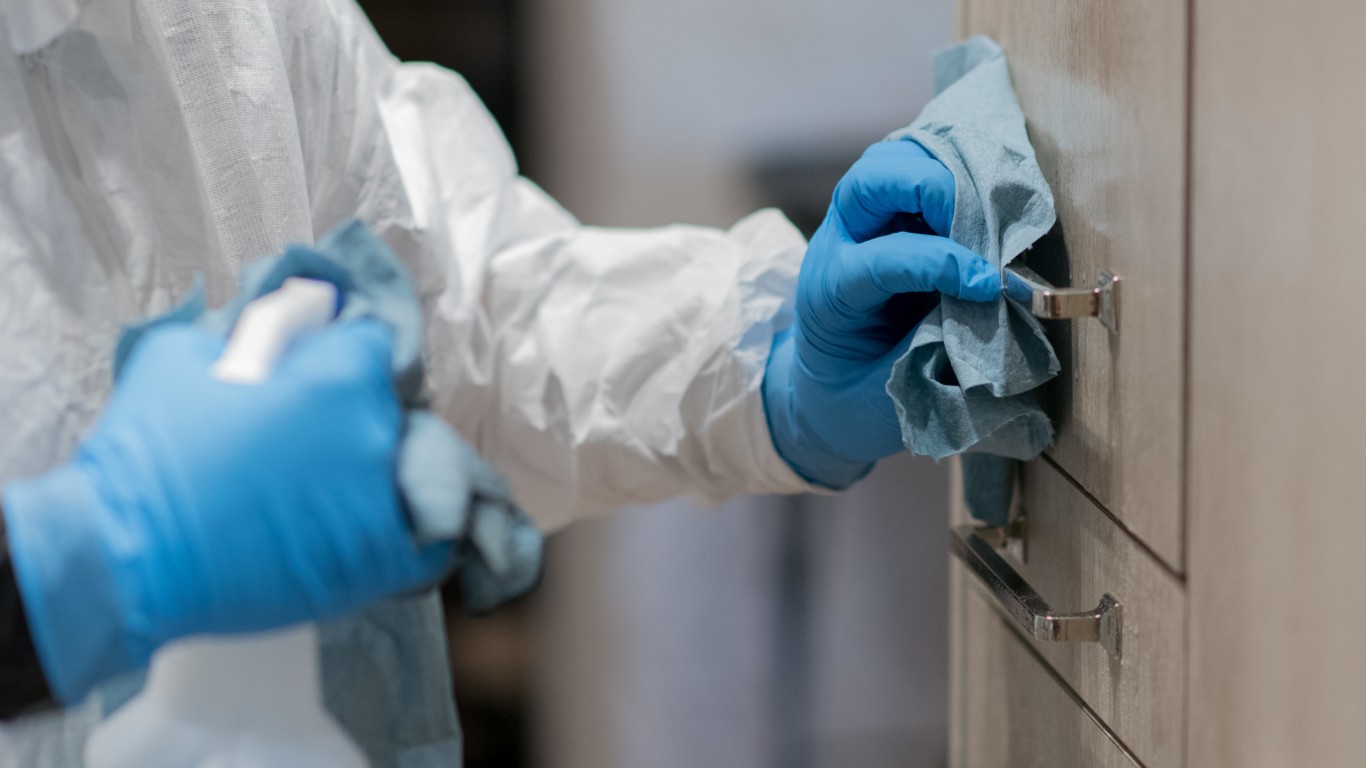
 24/7 Wall St.
24/7 Wall St.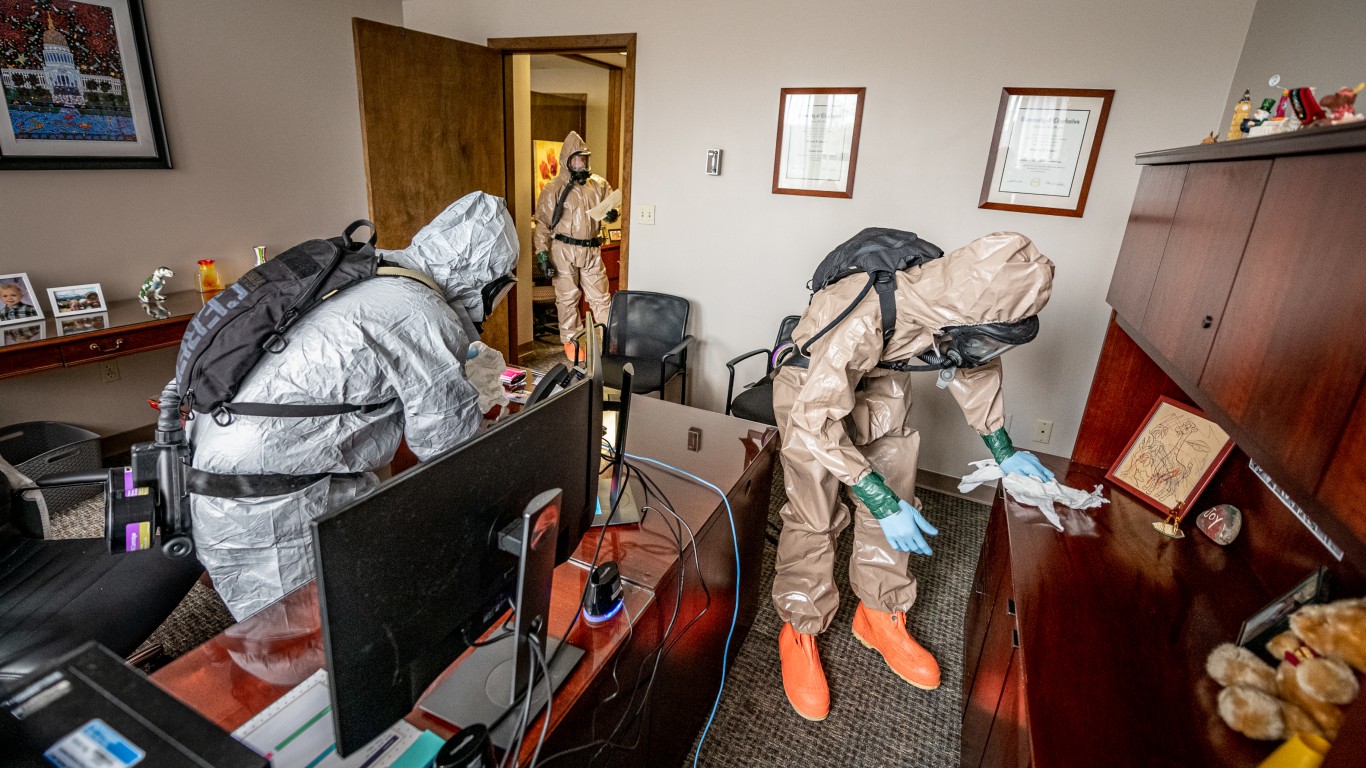
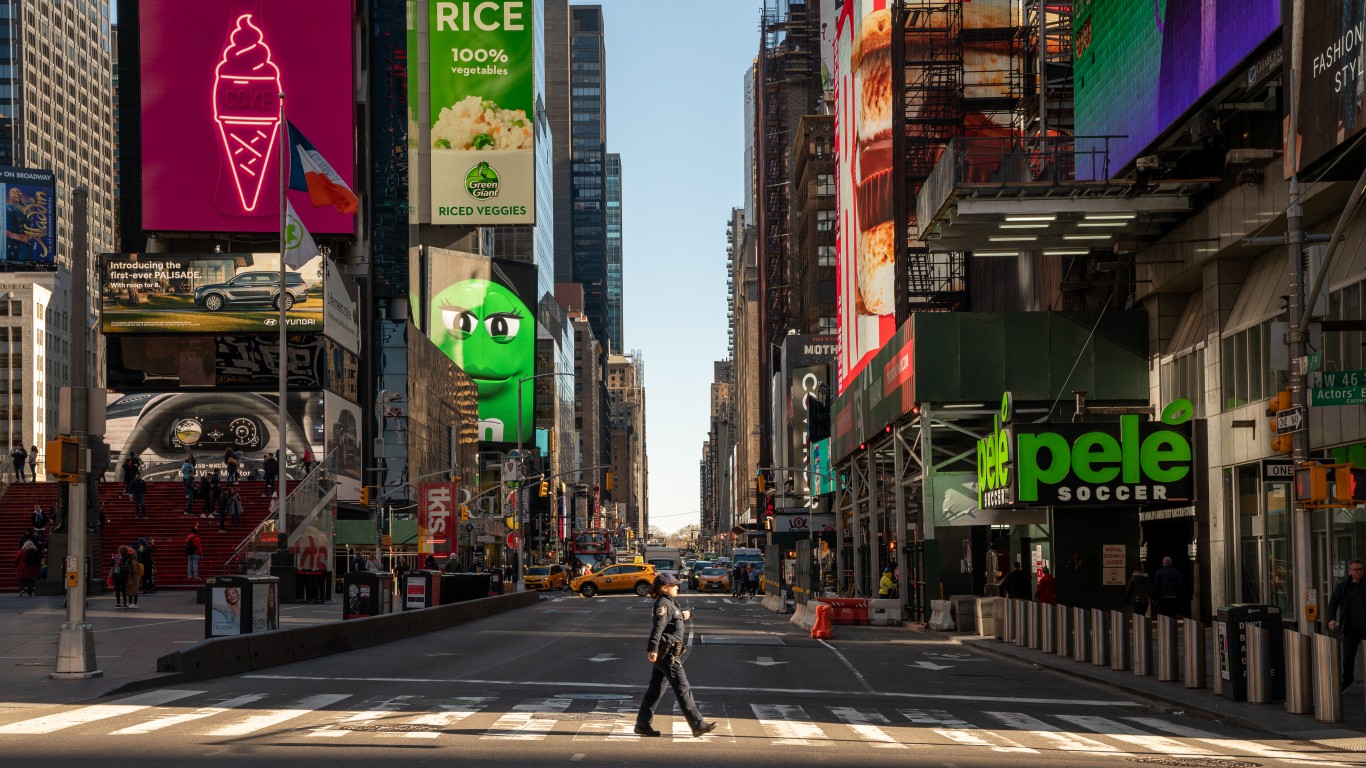 24/7 Wall St.
24/7 Wall St.